The Rise of Terroir in Champagne: Two Standout Producers In Search Of Precise Geography In Two Different Sub-regions (The Many Faces Of Meunier) + Recent Arrival: Clandestin ‘Elegant Champagne With A Burgundian Accent’
‘First and foremost, Champagne is wine.’
Our Champagne mantra over the past few years has been a bit reductionist: While undeniably accurate, it’s a little like saying that, first and foremost, ‘David’ is a hunk of marble or that at its essence, La Traviata is a bunch of notes. What these self-evident truths leave out is the human touch—the x-factor that makes art from the inanimate and beauty from the base.
As France warms with the rest of the planet, new regional wines are coming into focus and former sow’s ear soils are producing silk purse products. This is a paean to nature, of course, and as always, the passion arises from the people, not from the place. Folks like Alexandre and Fanny Heucq, fourth generation artisan winemakers from the grower house Champagne André Heucq and Olivier Langlais, the winemaker behind Solemme Champagne, who advocates simplicity and honesty in his wines.
These are two standout icons from our Champagne portfolio, but more than that, they are the flesh behind the finesse.
The Impact Of Climate Change on Champagne: Heating-up
Global wine production in 2023 was at its lowest in 60 years, and a lot of the decline can be blamed on extreme weather events, many of which have been worsened by climate change. Italy dropped from its position as the world’s leading wine maker due to numerous adverse weather events, including erratic rainfall that triggered downy mildew as well as floods, hailstorms and drought. In 2021—for the same reasons—Champagne saw the smallest harvest since 1957.
Somewhere amid all these clouds is a silver lining known as the Goldilocks Zone, and we may be living within it as we speak. Ripening grapes has always been a primary challenge in Champagne, located near the northern growing zone limit of its three principal grapes, Chardonnay, Pinot Noir and Meunier. Although the rise in temperature (nearly two degrees between 1961 and 2020) has beneficial effects in the short term, especially at higher elevations, the downsides are legion—earlier budburst makes the risk of frost damage more pronounced, and frost control systems, especially those based on combustion, add to the region’s carbon footprint. Not only that, but warmer days often precede warmer nights, affecting a grape’s natural ability to retain acid, giving Champagne its intangible ‘zing’.
Despite magnanimous efforts to reduce their carbon emissions, including use of bio-based products in the fields and cellars, scrapping much of the mineral fertilizers used in the past and planting of hedges and trees allowing a better absorption of CO2 and storage of carbon in soils, the warming of the region is likely to continue for the foreseeable future—potentially, according to ClimateAi, making Chardonnay and Pinot Noir (and to a slightly lesser extent, Meunier) impossible to grow in the area currently defined as Champagne.
That means we may well be in the midst of a ‘best of both worlds’ phenomenon in Champagne, where the positives still outweigh the negatives and we are able to enjoy riper, richer wine that is today (more often than in the past) of vintage quality. By 2050, who knows?
The Biodynamic Principles: Respecting Earth’s Life Forces
Credit Dr. Rudolph Steiner for codifying the basic principles of biodynamics; his 1924 lecture series to farmers opened a wormhole that integrated scientific understanding with a recognition of an underlying spirit in nature and, indeed, in the cosmos at large. In Cliff’s Notes shorthand, the movement recognizes every farm, garden or vineyard as an integrated organism made up of interdependent elements: Plants, animals, soils, compost, and the classically French view of ‘the spirit of a place.’ Biodynamic farmers listen to the land and work to nurture and harmonize these elements, managing them in a holistic and dynamic way. The goal, whether the crop is grain or grapes, is to develop and evolve a given plot of land as a unique individuality.
These principles are custom made to accentuate terroir, but in Champagne, distinctiveness of location has often taken a back seat to a homogenous blend. As a result, the region as a whole was a bit late to the biodynamic party. The era between 1970 and 2000 may be viewed as cringe-worthy in terms of viticulture; the overuse of pesticides and herbicides and the once-favored fertilizer known as ‘boues de ville’—urban waste—damaged soils even in the most prestigious Grand Cru vineyards.
The biodynamic sun came out at turn of the century, when the Comité Champagne conducted in-depth research into the industry’s environmental impact and launched an ambitious plan, resulting in a 20% reduction in carbon emissions per bottle and a 50% reduction in the use of both phytosanitary products and nitrogen fertilizers. A regional sustainability certification, VDC (Viticulture Durable en Champagne), was introduced in 2014 and today, 15% of Champagne’s vineyards falls under the certification, and ambitions are much higher for the future.
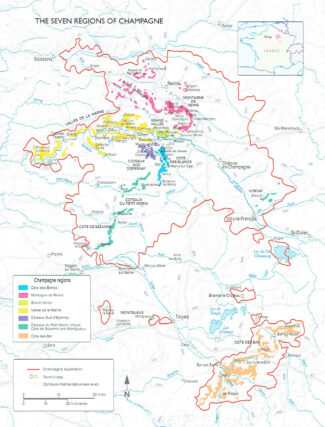
The Mountain, And Then The Valley: The Many Faces Of Meunier
For the trend conscious (as well as the eco-conscious), Meunier, often the odd-grape-out in discussions of Champagne dominant trio of varietal, is enjoying something of a heyday with a growing legion of fans, both for its frost-resistance and its bright, bergamot-tinted profile. Of the planted acres in Champagne, Meunier represents about 31%, or roughly 84,000 acres. In the Marne Valley, however, it dominates, making up more than 60% of the vineyards.
The valley is long—it extends more than sixty miles from the city of Tours-sur-Marne to Château-Thierry, wending thorough two départements, the Marne and the Aisne, all the way to the limits of Seine-et-Marne. As its name indicates, the Marne Valley follows the river through a landscape of rolling hills and small villages. Vines are planted on both banks although those on the north side benefit from a more favorable southern to eastern sun exposure.
The variety of Marne terroirs within its various villages and numerous sub-zones is expansive; in addition, the geology of the soils are more variable in Marne than in other Champagne sub-regions. As a result, the styles of Champagne, even those made mostly or entirely from Meunier, can vary widely. In the Petite Montagne, for example, the Meunier tends to be firmer and more structured, while the wines of the Vallée de la Marne are broader and more ample in build.
Representative of the many faces of Meunier are the artisan producers featured in this week’s selection, Alexandre and Fanny Heucq of Champagne André Heucq (whose mineral-focused Meunier is the result of their unique green Illite soils) and Olivier Langlais of Champagne Solemme, a vigneron who stands out from the pack as a true maverick, making Champagnes using only the year’s wines.
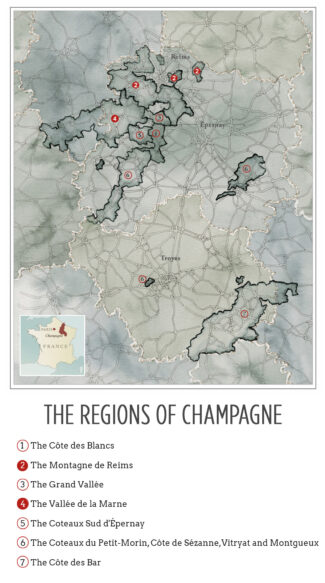
The Villages of The Vallée de la Marne: Coldest Weather in Champagne, Clay-Rich Soils
The most famous villages are located at the eastern end of the valley around the city of Épernay, a ranking that reflects the importance given to the presence of chalk in the soil. Chardonnay and Pinot Noir dominate the vineyards of the eastern end of the region, and the major Champagne houses located here include Billecart-Salmon or Philiponnat in Mareuil-sur-Aÿ, Deutz and Bollinger at Aÿ and Jacquesson in Dizy.
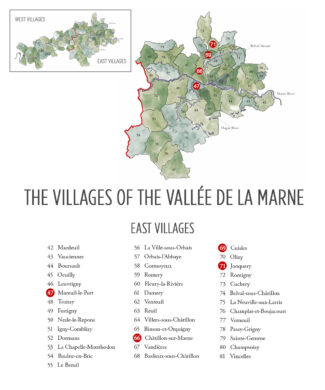
West of Châtillon-sur-Marne, chalk tends to be found more deeply buried in the ground; the topsoil is made of calcareous clay and clay marls. The combination of cold weather and rich clay makes Meunier the grape of choice in this part of the valley and it is here that a new generation of experimental winemakers is deepening their own (and by proxy) our understanding of the varietal.
Fanny & Alexandre Heucq
Champagne André Heucq
In the heart of the Marne valley is the tiny commune of Cuisles (population 150) which happens to be an epicenter for the green illite clay; it is unique to Cuisles and two surrounding villages and it is arguably the terroir where Meunier feels most at home.
According to André Heucq, who—along with his daughter Fanny— specializes in Meunier grown on fifteen acres of estate vineyards, “Green clay retains water better than chalky soils, this type of soil needs less water than classic clay-limestone soils. Generally speaking, the Marne Valley is prone to downpours of rain, and this is where Cuisles’ unique position in the hollow of the valley plays a fundamental role: Showers are much less frequent, so soil and climate are in perfect alchemy for optimum ripening of the Meunier.”
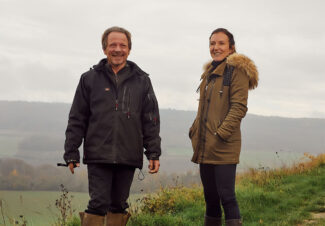
André & Fanny Heucq, Champagne André Heucq
Fanny says that the terroir, so vital to their wines’ purity and elegance, is enhanced by a commitment to biodynamics: “Production that respects the environment reactivates the vine’s natural self-defense mechanisms, allowing us to do away with the use of chemicals and use very low doses of copper and sulfur.”
Among the strictest (and most interesting) of the cosmos-oriented techniques the estate relies on is the ‘500’—a preparation is obtained by fermenting good quality cow manure in the soil over the winter, introduced via cow horns. Fanny explains, “This preparation is aimed at the soil and plant roots. Its name comes from the fact that it contains over 500 million bacteria per gram. The silica from the horn is equally important. It is complementary to and acts in polarity with the 500. It is not aimed at the soil, but at the aerial part of plants during their vegetative period. It can be said to be a kind of ‘light spray’, which can promote vegetative vigor or, on the contrary, attenuate excessive luxuriance. It brings a luminous (crystalline) quality to plants, and reduces their tendency to disease. Not only does it reinforce the effects of sunlight, it also enables a better relationship with the cosmic periphery, with the entire cosmos. This preparation is essential for the internal structuring and development of plants. It promotes vertical plant growth. It makes plants firmer and more supple. It increases the quality and resistance of leaf and fruit epidermis.”
Views From The Right Bank: Meunier Reigns Supreme
Not only an underdog but occasionally an afterthought, growers in Champagne have often planted Meunier vines in areas that will not support the appellation’s noble couple, Chardonnay and Pinot Noir. Older vines are often found in otherwise marginalized areas, and the grape is not permitted to wear the designation ‘Grand Cru’ even if it is grown exclusively in a Grand Cru village. As a logical result of this elitism, very little Meunier is grown in Grand Cru vineyards and many producers avoid using it in their vintage wines due to its rumored inability to age—a rumor which, incidentally, is unfounded.
As in Bordeaux, the difference between the right and left banks of the region’s dominant river are striking, both in terms of vineyard exposure and soil composition. The Marne is an eastern tributary of the Seine in an area east and southeast of Paris. In Champagne, where it runs west toward Épernay, the right bank sports the valued south/southeast exposure that maximizes sun exposure and aids grape ripening. As with the Right Bank of the Dordogne River in Bordeaux, the Marne’s right bank contains more clay, making it more suited to Meunier than either Chardonnay or Pinot Noir, which may struggle to ripen in the area’s cool, frost-and-fog-prone microclimate.
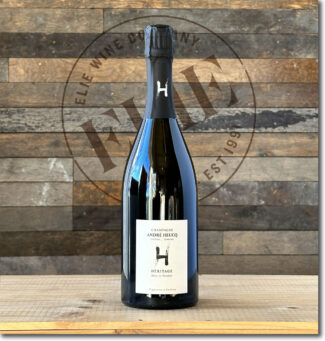 Champagne André Heucq ‘Héritage’ Blanc de Meunier, Vallée-de-la-Marne Brut Nature ($51)
Champagne André Heucq ‘Héritage’ Blanc de Meunier, Vallée-de-la-Marne Brut Nature ($51)
100% Meunier harvested in 2016/2017 from 30-year-old vines grown in illite-rich plots in Cuisles, Châtillon-sur-Marne, Serzy and Mareuil-le-Port. The wine underwent full malo and spent 48 months on lees; it was dosed to Brut Nature. The nose is nicely spiced with stewed apple and pear with notes of jasmine. A slight lemony bitterness on the finish is a mirror of the terroir. 25,000 bottles made.
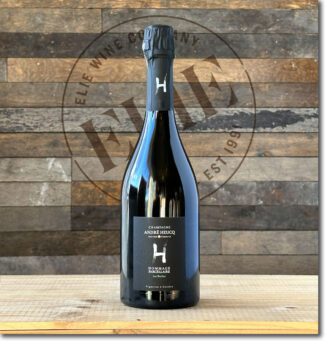 Champagne André Heucq ‘Hommage Parcellaire’, 2015 Vallée-de-la-Marne – Jonquery ‘Les Roches’ Brut Nature ($117)
Champagne André Heucq ‘Hommage Parcellaire’, 2015 Vallée-de-la-Marne – Jonquery ‘Les Roches’ Brut Nature ($117)
100% Meunier from younger vines—22 years old—grown in illite in the ‘Les Roches’ lieu-dit in Jonquery. The wine is from the 2015 harvest, fermented ‘en barrique’ and aged three years on lees after undergoing full malo. Dosed to Brut Nature. The wine’s bouquet is of peach and plum with notes of pie crust and almond. The long and pronounced minerality in the finish is indeed an earthy homage to the parcel from which it arises. Only 800 bottles were made.
The Montagne de Reims: Grande, Petite, North And The Grand Vallée
Located between Reims and Épernay, the Montagne de Reims is a relatively low-lying (under a thousand feet in elevation) plateau, mostly draped in thick forest. Vines find a suitable home on the flanks, forming a horseshoe that opens to the west.
So varied are the soils, topography and microclimates here that it is not possible to speak of the region in any unified sense. Grande Montagne de Reims, which contains all of the region’s Grand Cru vineyards, covers the northern, eastern and southern slopes of the viticultural area, and Pinot Noir plantings dominate at 57%, followed by Chardonnay (30%) and Meunier (13%). Its vineyards face a multitude of directions, and soil type varies by village, giving rise to a breadth of Pinot Noir expressions, as well as exceptional Chardonnay.
To the west, the Grande Montagne de Reims gives way to the Petite, whose bedrock is chalk, but softer than the chalk found further south on the Côte des Blancs. This sort, called ‘tuffeau’, is an extremely porous, sand-rich, calcium carbonate rock similar to what is found in wine regions of the middle Loire Valley.
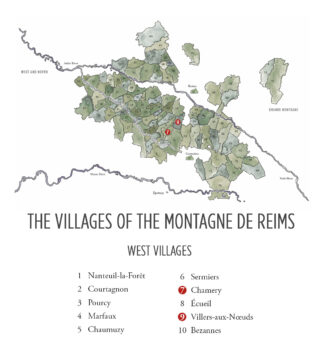
In French, the word ‘petite’ often to refers to a ‘lesser’ commodity, but with La Petite Montagne, the reference is to elevation. This lower elevation means warmer weather, even in Champagne’s northerly climate, and in certain villages, the soil contains more sand, making it an ideal environment for growing Meunier.
Meunier accounts for approximately half of the plantings in the Petite Montagne, with Pinot Noir making up 35% and the rest Chardonnay. It is a growing conviction among growers of the modern era that Meunier is a Champagne grape whose time has come, especially as an age-worthy variety.
Emmanuel Brochet of Villers-aux-Nœuds says, “People claim that Meunier ages too quickly, even faster than Chardonnay. I disagree. The curve of evolution is different. Meunier is quick to open and more approachable in youth, but then it becomes quite stable. Chardonnay tends to open later, but old Meunier remains very fresh and lively.”
Olivier Langlais
Champagne Solemme
The name Solemme is a combination of ‘sol’ for the sun, with the addition of a feminine suffix. “My goal,” says cellar master Olivier Langlais, “is to make delicate Champagnes that are bright like the sun.”
La Petite Montagne-de-Reims, to the west of the road between Reims and Épernay, boasts steep slopes and chalky soils, making it the home of some of the best vineyards in Champagne—Savart, Brochet, Egly-Ouriet, etc. Also calling the region home is Olivier Langlais, who farms fifteen acres of organic vineyards in the terroir around Villers-Aux-Nœuds. A true exception in Champagne region, he makes wines using only the product of the harvest year.
His dedication to biodynamics and agriculture according to the cycles of the moon began with the Chardonnay plot in 2009 and finished the transition with his oldest vines of Pinot Noir in 2015. The vineyard is composed of 50% Meunier, 25% Chardonnay and 25% Pinot Noir divided between six villages—five of them Premier Cru. Most of the plots, as is the case of most Petite Montagne de Reims vines, are southeast/east oriented.
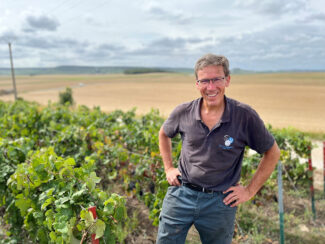
Olivier Langlais, Champagne Solemme
“Everything is happening in the exchange between the soil and the grape,” Olivier points out. “That’s why the difference of terroir between all parcels determines variety and process. Villers-aux-Nœuds has a classic chalky soil, bringing a lot of minerality to the Chardonnay and Meunier growing there. Clay-limestone dominates Chamery and Vrigny, with a bit more clay in Vrigny, where Meunier gets better results—clay gives more ‘gras’, or roundness to the grapes. Often not mentioned is the sandy soils of Villedomange and Éceuil, which gives Pinot Noir a concentrated and elegant form.”
Once in the cellar, Olivier is a champion of a hands-off approach. He never chaptalizes and uses only natural yeast from his vineyard. “In the chai, you won’t find any barrels,” he says. “We do not filter, there is no addition of SO2 and all the cuvées spend between 36 to 48 months on the lees as a means of better expressing the terroir. 90% of the time, I don’t do any malolactic fermentation, because I prefer to let the natural minerality shine.”
Varietal Transformation in The Petite Montagne: Meunier Shares Space With Pinot Noir
The western portion of the Montagne de Reim—the so-called Petite Montagne—stretches from Gueux in the north to Sermiers in the south, on the western side of the main road that runs between Épernay and Reims. Although this region has a historical fondness for Meunier, some acres have been replanted to Pinot Noir in recent years, potentially doing a disservice to the vineyards north of Écueil in the villages of Sacy, Villedomange, Jouy-lès-Reims, Coulommes-la-Montagne, Vrigny and Gueux. But the soils here are generally more overtly calcareous than those in the Vallée de la Marne and can contain a high proportion of fossils. In Écueil, there is sand on the lower slopes, acting as a defense against phylloxera, allowing some growers to plant Pinot Noir on the original rootstocks, so this becomes the cultivar of choice.
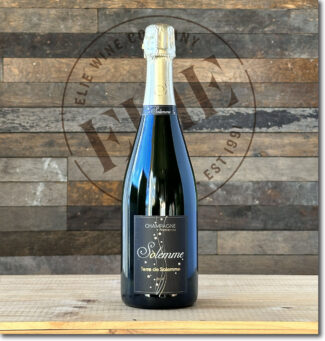 Champagne Solemme ‘Terre de Solemme’, Montagne-de-Reims Premier Cru Villers-aux-Nœuds Brut ($59)
Champagne Solemme ‘Terre de Solemme’, Montagne-de-Reims Premier Cru Villers-aux-Nœuds Brut ($59)
Villers-aux-Nœuds is a Premier Cru village in Vesle et Ardre; about half the vineyards are planted to Pinot Noir, with Meunier making up about 30%, and the rest, Chardonnay. Olivier Langlais farms fifteen acres here; the land is relentless hilly and the soil is made up of Cretaceous chalk under a few inches of ‘argilo-calcaire’ topsoil. Disgorged according to the moon cycle (a feature of his brand of biodynamics), ‘Terre Solemme’ is a blend of 55% Meunier, 25% Pinot Noir, and 20% Chardonnay aged three years on the lees. Buttery toast on the nose along with cooked apple and cantaloupe. The palate has an echo of the nose and a nice marzipan richness that drives the mineral finish home.
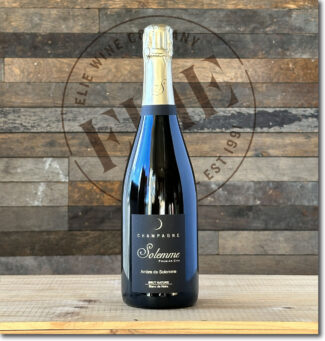 Champagne Solemme ‘Ambre de Solemme’, 2016 Montagne-de-Reims Premier Cru Villers-aux-Nœuds ‘La Motelle’ Blanc de Noirs Brut Nature ($99)
Champagne Solemme ‘Ambre de Solemme’, 2016 Montagne-de-Reims Premier Cru Villers-aux-Nœuds ‘La Motelle’ Blanc de Noirs Brut Nature ($99)
100% Meunier from the ‘La Motelle’ lieu-dit, filled with 50-year-old Massal-selected vines; these grapes were harvested somewhat late and developed a spectacular ripeness. ‘Ambre’ refers to the color, whose slight tint is the result of skin-contact. The nose sets out with fresh apple and a touch of grapefruit and strawberry coming out, with bold acidity reflected in a spine of salinity that balances an otherwise rich and creamy wine.
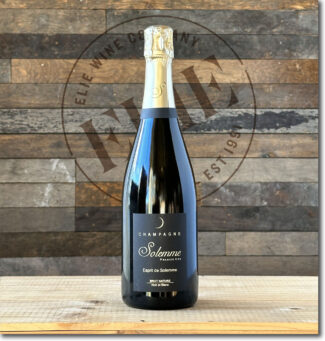 Champagne Solemme ‘Esprit de Solemme’, 2018 Montagne-de-Reims Premier Cru Brut Nature ($79)
Champagne Solemme ‘Esprit de Solemme’, 2018 Montagne-de-Reims Premier Cru Brut Nature ($79)
2018 was an excellent vintage in Champagne; the crop was large and healthy, rich in sugar and flavor depth, with all three major grape varieties performing well. ‘Esprit de Solemme’, 2018, is equal parts Meunier and Chardonnay drawn from chalky soil in Villers-aux-Nœuds and the clay-limestone hillsides of Chamery. This cuvée shows a lovely bouquet: cream, biscuits, pineapple and toasted nuts. The palate is very dry but stays in balance with cream and salinity through the finish.
RECENT ARRIVAL
The wine world is a churning urn of burning trends, and what catches fire in America is not necessarily the same thing that ignites Europe: The concept of ‘grower Champagne’, for example, often carries more weight here than it does among the Champenois producers themselves. Champagne made in-house from grapes grown on the estate may wear the grower Champagne label, while the majority of Champagne houses purchase grapes as négociants and create signature blends. When a house wears ‘Domaine’ on the label, it is the former; ‘Maison’ generally represents the latter.
Between the two is the micro-négociant, who operates on a smaller scale and often produces high-quality micro-cuvées, controlling production from vineyard to bottling, and focuses on representing individual vineyard sites.
One micro-négociant estate that is capturing attention of both here and in Aube is Champagne Clandestin, a joint venture between Meursault-trained winemaker Benoît Doussot and Aube legend Bertrand Gautherot of Vouette & Sorbée.
Micro-Négociant
Champagne Clandestin
‘Elegant Champagne with a Burgundian Accent’
‘Clandestin’ means exactly what you think it does—something hidden, something to be explored. In this case, it refers to the Aube’s long-overlooked, west-facing parcels of Pinot Noir on Kimmeridgian soils as well as Chardonnay on Portlandian soils above Buxières.
These cuvées represent vineyards that have generally been eschewed in the region; southerly, easterly and southeastern-facing parcels have long been favored in the Aube because they are exposed to more sunlight during day while their western counterparts have never been fully utilized. Both Bertrand and Benoît were convinced that a longer and slower ripening and maturation process could imbue the wines with added complexity and depth. Clandestin is made from 20 acres of cooler, west-facing vineyards, which are farmed organically, certified by ECOCERT and vinified according to the exacting standards for which Vouette & Sorbée is known.
Benoît says, “After pressing, the wine is aged in French oak barrels following closely the training I received in Meursault before moving north to Champagne. This wine should appeal to purists in search of minerality, cut, and precision. Because we insist on harvesting perfectly ripe grapes, which is not generally the case in Champagne, the wines can be bottled with no dosage, giving room for the oceanic terroir to really shine through.”
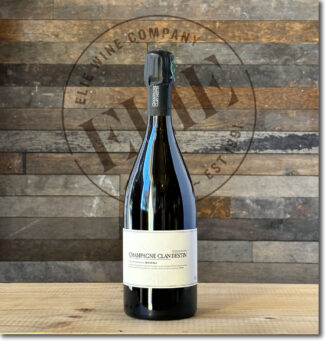 nv Champagne Clan Destin ‘BORÉAL’ Côte-des-Bar Brut Nature ($79)
nv Champagne Clan Destin ‘BORÉAL’ Côte-des-Bar Brut Nature ($79)
Harvest 2020. 100% Pinot Noir grown on vines between 20-35 years old, fermented and aged in French oak before aging sur latte for 15 months before being disgorged with zero dosage. Earthy aromas of wild strawberries, brioche and toast waft from the flute followed by a delicate mineral crunch. Disgorged July 2022.
Notebook ….
Single Harvest vs. Vintage
In France, under Appellation d’Origine Contrôlée (AOC) rules, vintage Champagnes must be aged for three years—more than twice the required aging time for NV Champagne. The additional years on the yeast is said to add complexity and texture to the finished wine, and the price commanded by Vintage Champagne may in part be accounted for by the cellar space the wine takes up while aging.
On the other hand, a Champagne maker might prefer to release wine from a single vintage without the aging requirement; the freshness inherent in non-vintage Champagnes is one of its effervescent highlights. In this case, the wine label may announce the year, but the Champagne itself is referred to as ‘Single Harvest’ rather than ‘Vintage’.
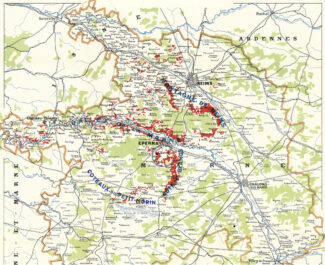
Drawing The Boundaries of The Champagne Region
To be Champagne is to be an aristocrat. Your origins may be humble and your feet may be in the dirt; your hands are scarred from pruning and your back aches from moving barrels. But your head is always in the stars.
As such, the struggle to preserve its identity has been at the heart of Champagne’s self-confidence. Although the Champagne controlled designation of origin (AOC) wasn’t recognized until 1936, defense of the designation by its producers goes back much further. Since the first bubble burst in the first glass of sparkling wine in Hautvillers Abbey, producers in Champagne have maintained that their terroirs are unique to the region and any other wine that bears the name is a pretender to their effervescent throne.
The INAO defines the concept like this: “An AOP area is born of an alliance between the natural environment and human ingenuity. From that alliance comes an AOP product with unique, inimitable characteristics, a product so different that it complements rather than competes with other products, possessing a particular identity that adds further value.”
In 1927, the viticultural boundaries of Champagne were legally defined and split into five wine-producing districts: The Aube, Côte des Blancs, Côte de Sézanne, Montagne de Reims, and Vallée de la Marne. The CIVC (Comité Interprofessionnel du vin de Champagne), formed in 1941, decreed that everyone who wanted to plant vines and grow grapes to be used in the creation of Champagne had to be registered, and if you didn’t register back then, there is no out, even now. Originally, grape growing was not a profitable business and was an afterthought meant to utilize chalky slopes where grain would not grow. As a result, many farmers at that time did not register, and today, a tour along the Route Touristique de Champagne, you’ll come across unregistered fields that lie fallow between two registered vineyards.
… Yet another reason why this tiny slice of northern France, a mere 132 square miles, remains both elite and precious.
- - -
Posted on 2024.01.14 in France, Champagne, Wine-Aid Packages | Read more...
A Window To The Past: Burgundy’s Strongest Statement is Fully In Evidence In Ten-Year-Old Gevrey-Chambertin Seventeen 2014 Wines Show Depth And Breed. (4-Bottle Village-Pack $379) + (3-Bottle Premier Cru-Pack $379)
A Gevrey New Year from us to you! In a time of reflection and introspection, we’re also suggesting a bit of ‘retrospection’—a deep dive into the marvelously mature 2014s from the Burgundian appellation most celebrated for its longevity. This curated selection is a window into the art of evolution as it applies to Gevrey-Chambertin Pinot Noir held in ideal conditions for the past decade. From some of the finest producers in Gevrey, these are wines which emerge from their chrysalis of cellaring to display the nuanced emotion, complexity, refinement and texture that only patience can reveal.
Consider this a celebration of the moment when you truly recognize that a wine’s aroma has become its bouquet.

What Makes A Wine Great?
Superlative winemaking involves a formula that’s part science and part soul. It’s not a stretch to liken the process to a recipe, and so a comparison of a great wine and the steps required to produce a perfectly prepared, top-end Wagyu ribeye steak may be apropos. Like wine, an exceptional piece of beef must trace its origins to the earth itself: Wagyu cattle are pampered from birth, fed a high-protein diet, often massaged and given beer to encourage marbling. Likewise, the vineyards that produce top quality wines enjoy both breeding and babying; adding to the natural elements is a cycle of biodynamics to mollycoddle microbic life, with the correct attention paid to moisture, food and pruning. While in the growth stage, all possible care is taken so that the vines do not fall prey to disease or mismanagement.
And the same holds true for the steer.
Once harvested, both products are handled with extra care, but in the cellar—as in the kitchen—the skill of the creator is paramount. A misstep along the way may result in a whole lot of wasted effort earlier in the game.
Of course, for both beef and bottle, the consumer is the ultimate benefactor and the decisive judge; the time the wine spends maturing toward an ‘ideal’ state is the time the steak spends over the flame. This is, of course, an optimal and somewhat measurable period depending on individual tastes, but a given consensus can certainly be formed and debated.
And this is precisely the key factor separating great wine (and great cuisine) from the also-rans, just as it is true that the broader the consensus, the pricier the product tends to become.
The esoterica we consider when we call a wine ‘great’ are nuance and identity. The former is formed purely through organoleptic sensations, the latter via reputation and history—how well the wine represents and reflects its place of origin. The status of ‘great’ must always be opinion, but at the same time, the more you know and the deeper you look, the more credible your opinion becomes.
So, to ring in 2024, let’s raid the cellar and fire up the grill and put these theories to the ultimate test!
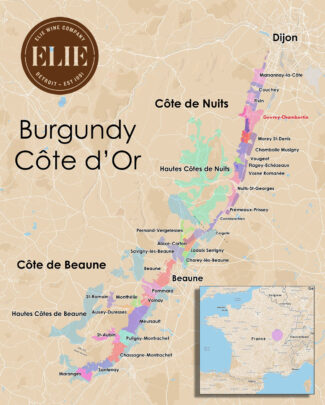
Gevrey-Chambertin: Setting The Boundaries
“The Emperor will drink only Chambertin,” said Louis Constant Wairy, Napoleon’s valet.
Indeed. So what does Gevrey-Chambertin have in common with Westland, Michigan? Not much, except that Westland was named for a mall and Gevrey-Chambertin is named for a vineyard. As those schooled in Burgundian lore know, during the nineteenth century it became fashionable for villages in the Côte d’Or to adopt double-barreled names, adding a hyphen followed by the name of their most famous vineyard: Thus Chambolle added Musigny and Gevrey added Chambertin.
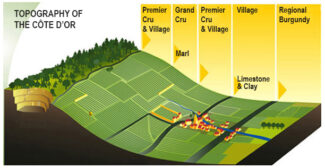
In minimalism, less may be more, and in wine—especially those with a hyphenated name—more may be less; a village-level Gevrey-Chambertin, for example, does not seek to compete with the quality of ‘Le Chambertin’ itself. But if nothing else, its name reminds you that it comes from a rarefied zip code. And to be sure, the region is hallowed grapeland, graced with the Holy Trinity of terroir—elevation, climate and soil structure. Contained within the appellation are nine Grand Crus and 26 Premier Crus (whose name on the label may be followed by the name of the climat of origin) as well as nearly a thousand acres of Villages wine.
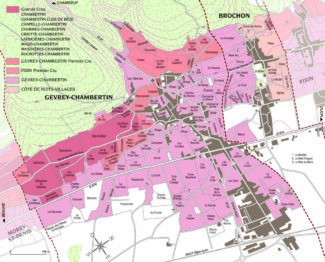
The 2014 Vintage: Ten Years Of Age Matures Into A Classic
If you follow this sort of thing, you know that in Burgundy, Vintage 2015 was a media-magnet, extraordinary throughout the Côte d’Or. A mild, wet winter replenished water reserves sorely needed during a hot, dry summer. A few inches of rain in June, followed by a further inch or so in August—critical to refresh the vineyards and ensure even ripening, but not so much as to mask the region’s diverse terroir in sweet fruit.
All this 5/5 scoring talk is fine, but it should not serve as temptation for any true Burgundy lover to overlook 2014.
A more difficult vintage by all accounts, the summer of 2014 was wet and chilly interspersed with a few hot days in July and worsening weather during the first half of August. There was surprisingly little mildew, but maturation proceeded slowly. And then, things took a turn for the better: The skies cleared, the mercury rose, and victory was seized from the jaws of disease, decimated yields and vinegar flies.
Especially in the Côte de Nuits, the final verdict is just becoming obvious. The wines, though less voluptuous and rich than 2009 or 2012, but also riper than 2008 (which had a similar growing season) have proven to be classic. Ten years later, the proof is in the goblet; these wines, pure and limpid at bottling, have matured admirably and are of a weight and concentration that indicates near peak performance.
Domaine Dominique Gallois
Prior to taking over the family estate in 1989, Dominique Gallois studied catering in Paris and ran his own restaurant for six years. When he returned to Burgundy, the domain consisted of six acres in Gevrey-Chambertin which his father had managed for forty years, selling the grapes to négociants. Dominique began to renovate the property and in 1989 (after purchasing additional acreage in Combe aux Moines, Petits Cazetiers and Goulots) to bottle his own product, looking first to private customers to build a reputation.
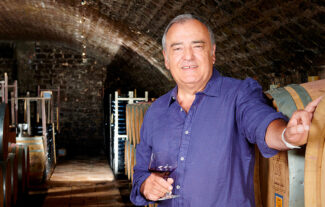
Dominique Gallois, Domaine Dominique Gallois
Recognizing that he works in terroir that is the envy of the world, Dominique takes special care to work the domain by hand, without pesticides or herbicides. Says Gallois, “Our year is quite full; winter months are dedicated to vine maintenance and Guyot-style pruning. During spring and summer, several tasks are performed allowing yields to be controlled and managing the healthiness of the future grapes. Harvesting is manual—we count on a small, faithful team to carry out the first sorting on the vine. Thereafter, grapes pass over a sorting table where bunches are inspected so as to conserve only the best fruit.”
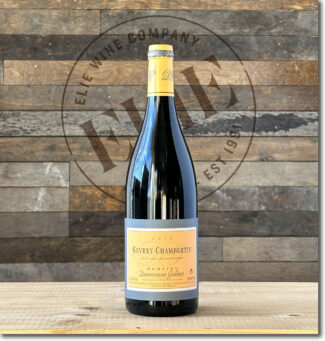 Bottle 1 • Village Pack
Bottle 1 • Village Pack
Domaine Dominique Gallois, 2014 Gevrey-Chambertin ($95)
In Burgundy, any serious discussion of terroir begins at the Village level, and the most important of these appellations are aligned in a neat north-to-south line from Marsannay to Maranges. They generally located on a commune’s eastern side, where the angle of slope is slight, or along the far western fringe, adjacent to forest-capped ridgelines, where both elevation and slope are far more significant. Not all are created equal, of course, and it can be expected that the concentration of Gallois’ Gevrey, blended from numerous climats and celebrating its tenth anniversary, is at its finest. The nose shows deep cherry spice, licorice, and earth, with perfectly integrated oak and fruit leather, the palate cinnamon and black pepper and a finish that remains both rugged and refined.
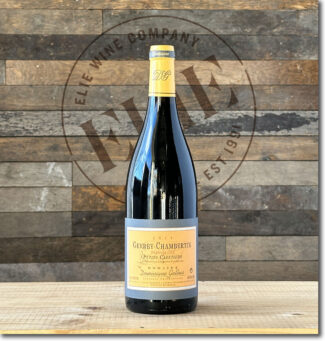 Bottle 1 • Premier Cru Pack
Bottle 1 • Premier Cru Pack
Domaine Dominique Gallois, 2014 Gevrey-Chambertin Premier Cru Petits Cazetiers ($120)
Les Petits Cazetiers is a tiny Premier Cru climat just west of the village of Gevrey-Chambertin; the enclave is walled and planted entirely to Pinot Noir, covering barely two acres. In fact, Gallois is the only producer making a wine under the Les Petits Cazetiers Premier Cru name. From the well-drained limestone and marl comes a wine rich in earth tones, most notably mushroom, which has evolved into tertiary notes of nuts, spice and dried cherry.
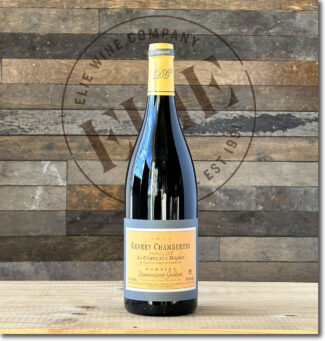 Domaine Dominique Gallois, 2014 Gevrey-Chambertin Premier Cru La Combe aux Moines ($150)
Domaine Dominique Gallois, 2014 Gevrey-Chambertin Premier Cru La Combe aux Moines ($150)
At 1300 feet, Combe aux Moines is among most elevated in Burgundy, and the wines are both rarefied and rustic, exhibiting bright red fruit alongside earthy characters. The 12-acre climat sits at Gevrey’s northern end, quite a distance from the contiguous Grand Cru hill. Instead, Combe aux Moines is bounded by other east-facing Premier Cru climats like Les Cazetiers and Champeaux. It angles slightly north, meaning that the vines have less exposure to the sunshine than the south-facing vineyards that lie just outside the village; however, the steep slope ensures that the morning sunlight is distributed efficiently. Soils are free draining and fairly infertile, lessening the vigor of the vines and leading to the production of small, concentrated grapes often been linked to the muscularity of the finished wines. This one retains a solid core of red fruit behind the savory scents of tobacco and forest floor.
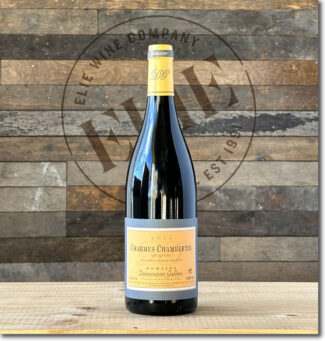 Domaine Domonique Gallois, 2014 Charmes-Chambertin Grand Cru ($390)
Domaine Domonique Gallois, 2014 Charmes-Chambertin Grand Cru ($390)
One of the lesser known Grand Cru sites in Gevrey, Charmes occupies the lowest and most shallow slopes of the Grand Cru belt close to the border with Morey-Saint-Denis. It consists of a number of blocks divided by minor roads or walls and in general, produces softer, less muscular wines than many of its neighboring Grand Crus, including Chambertin itself. As such, the longevity is not as pronounced, and in consequence, tends to mature more quickly. It remains a varsity-level Burgundy, however, with a deeply structured core, showing the cherry, bilberry of its youth along with the mineral and spice of adulthood, then happily builds to a stone and spice finish that displays equilibrium and finesse.
Domaine des Tilleuls
Damien Livéra, whose Italian great-grandfather founded the domain in 1920, decided on a different approach when he took the reins in 2007. Formerly a wine made from négociant-purchased fruit (mostly Bouchard Père and Louis Jadot) Damien decided to go maverick. First he improved the Tilleuls’ ‘cuverie’—wine storehouse—and expanded the amount of wine drawn from the domain’s 21 acres that was bottled in house. This vineyard land includes plots of Bourgogne, Hautes-Côtes de Nuits, Fixin, and Gevrey-Chambertin, the Crus En Champs, Évocelles and Clos Village as well as a plot of Chapelle-Chambertin in the sub-climat Gémaux.
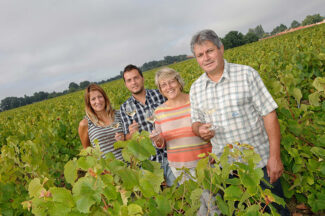
Damien Livéra and Family, Domaine des Tilleuls
Damien also made a push to see the family’s vines cared for with a more earth-friendly and quality-focused attitude, pushing for lower yields and healthier, more balanced fruit. Vineyards are cared for sustainably, which includes plowing the soils (no herbicides) and using indigenous yeasts in the cellar. A majority of the estate’s older Pinot Noir vines were planted in the 1950s and 1960s. Grapes are harvested by hand and mostly destemmed, fermented in tank and then aged in French oak barrels in very cold cellars—so cold that malolactic fermentations may extend over a full year. The family uses from 25% new oak on base wines to 40 percent on Villages-level wines and between 50 to 100% for Grand Crus. Selections are bottled unfined and unfiltered.
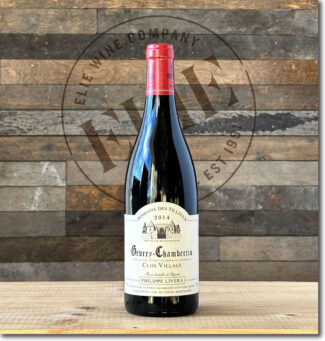 Bottle 2 • Village Pack
Bottle 2 • Village Pack
Domaine des Tilleuls, 2014 Gevrey-Chambertin ‘Clos Village’ ($94)
This is the Livéra family’s flagship wine; they own four acres of the Gevrey-Chambertin wall-enclosed Clos Village and make the wine with the intention that it be cellared: Vinified in 40% new oak for 12 months and then 6 months in stainless-steel vats, with neither fining nor filtration. Damien Livéra recommends waiting a minimum of 5 years before opening; ten if circumstances allow. A complex and structured wine in the full bloom of earthy elegance.
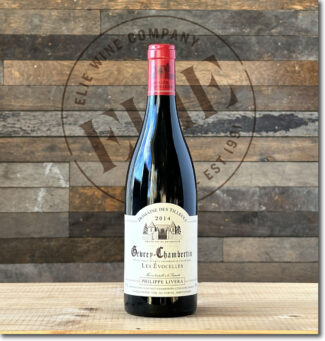 Domaine des Tilleuls, 2014 Gevrey-Chambertin ‘Les Évocelles’ ($94)
Domaine des Tilleuls, 2014 Gevrey-Chambertin ‘Les Évocelles’ ($94)
Évocelles is a 25-acre upper-hillside vineyard, sharply inclined and full of stones. It is located at the very north-east portion of Gevrey, principally in Brochon, bordering the Premier Cru of Champeaux and Les Goulots. The primary geology of this Village-level lieu-dit is clay-limestone and the vines were planted in 1950. The palate remains medium-bodied with still-supple tannins and a fine bead of acidity—quite an elegant Les Évocelles with a lightly spiced finish.
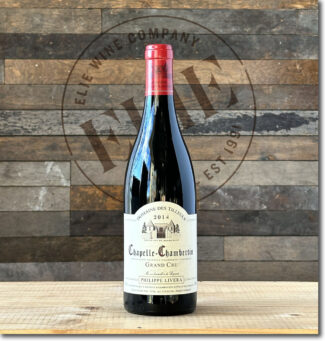 Domaine des Tilleuls, 2014 Chapelle-Chambertin Grand Cru ($350)
Domaine des Tilleuls, 2014 Chapelle-Chambertin Grand Cru ($350)
One of the area’s lesser-known sites in the Grand Cru belt, Chapelle is located immediately below the commune’s more prestigious climat, Chambertin Clos-de-Bèze. It covers 13.5 acres of limestone-rich soil whose stony texture allows for free drainage and forces the vines to grow deep, strong root systems in search of water. In ideal seasons, warm days and cool nights help the grapes maintain a balance between natural sugars and acidity, which echo in the finished wines. In the 2014 vintage, the terroir has emerged from behind overt vintage character and is now clearly on display, having mellowed into appealing and exotic aromatics.
Thibault Liger-Belair
Winemaking has been the legacy of Liger-Belair family for a quarter of a millennium. Prior to establishing his own domain, Domaine Thibault Liger-Belair studied oenology, worked for a communications firm in Paris and started an internet company to discover and sell high quality wines. Still, the vines beckoned, and in 2001, at the age of 26, he returned to them. The following year saw his first harvest of Nuits-Saint-Georges, and in 2003, he expanded into Richebourg Grand Cru, Clos Vougeot Grand Cru and Vosne-Romanée Premier Cru Petits Monts and in 2004, he discovered biodynamics, a train on which he has been a front-row passenger ever since.
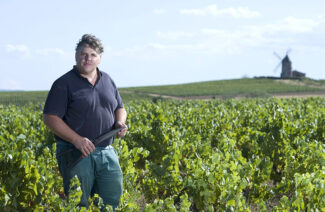
Thibault Liger-Belair
“I saw a change in my vineyard, which went from grey soils to brown/red and then sometimes to black.” Still, his overarching philosophy is that each vineyard needs something different: “I don’t like 100% of anything: new barrels, whole clusters. My job is to decide which grapes we have and then decide a viticulture and winemaking approach.”
In 2018, he made wine from 23 different appellations and purchased grapes from a ten more, but did the work there. “We don’t purchase grapes where we don’t do the work,” he says.
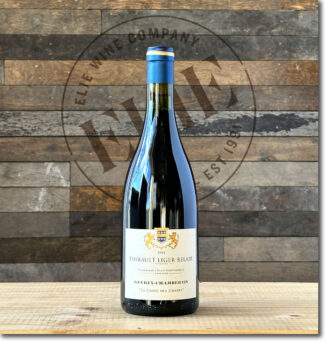 Bottle 3 • Village Pack
Bottle 3 • Village Pack
Thibault Liger-Belair, 2014 Gevrey-Chambertin ‘La Croix des Champs’ ($99)
Liger-Belair’s scant 1-acre parcel of 40-year-old vines is grown in the fairly rich soils of La Croix des Champs lieu-dit on the far side of the Route Nationale. The wine remains expansive with a solid and, complex mineral layer, well integrated oak and fine-grained tannins behind notes of tarragon, cedar and chocolate.
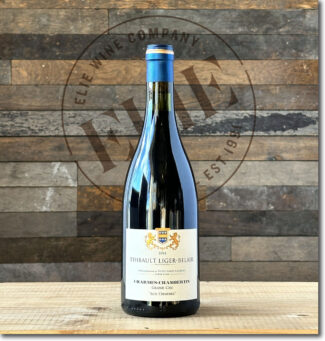 Thibault Liger-Belair, 2014 Charmes-Chambertin ‘Aux Charmes’ Grand Cru ($370)
Thibault Liger-Belair, 2014 Charmes-Chambertin ‘Aux Charmes’ Grand Cru ($370)
‘Aux Charmes’ borders the Grand Cru Chambertin; it is east-facing with iron-rich soils and vines between 80 and 100 years old. Thibault Liger-Belair’s parcel was planted in 1946, three-quarters of an acre located at the top of the vineyard, just below the border between Chambertin and Latricières. The ‘greenness’ of the scent remains intact as an integral part of this wine’s beauty, with touches of herbal tea and underbrush.
Domaine Heresztyn-Mazzini
Florence and Simon Heresztyn-Mazzini hail from different winemaking regions—Florence from Burgundy and Simon from Champagne. After ten years of working Heresztyn-owned vineyards in Gevrey-Chambertin, the couple decided to start their own venture on 14 acres spread across the villages of Gevrey-Chambertin, Morey-Saint-Denis, and Chambolle-Musigny. 2012 was their first vintage.
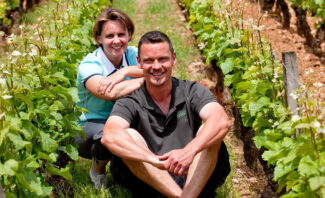
Florence and Simon Heresztyn-Mazzini, Domaine Heresztyn-Mazzini
“Here in Gevrey-Chambertin,” Simon says, “we have had only this one objective since 2012: to work according to organic and biodynamic practices in the vineyard, vat-house, and cellar and to offer Grand Cru, Premier Crus and Village wines that are closest to the identity of their climats. Our vineyards were certified organic in 2014 and we have been farming biodynamically in 2015.”
Florence adds, “We are closely attached to the Côte de Nuits and its unique terroirs and work relentless to bring out the region’s best qualities. Simon and I make it a point of personal pride to respect the region’s soils and natural environment.”
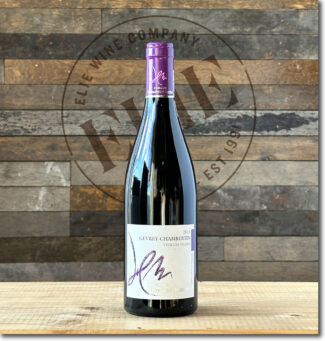 Bottle 4 • Village Pack
Bottle 4 • Village Pack
Domaine Heresztyn Mazzini ‘Vieilles Vignes’, 2014 Gevrey-Chambertin ($91)
Pinot Noir made from 50 year-old vines and aged in Allier and Tronçais barrels for 18 months; it holds onto a great portion of its dark fruits and tannic spine. An exceptionally well-made Village wine that has received better reviews than several Premier Cru Gevreys from the 2014 vintage.
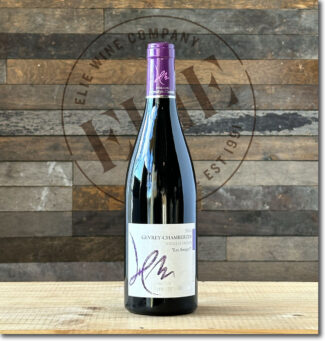 2014 Domaine Heresztyn Mazzini ‘Vieilles Vignes’ Gevrey-Chambertin ‘Les Songes’ ($91)
2014 Domaine Heresztyn Mazzini ‘Vieilles Vignes’ Gevrey-Chambertin ‘Les Songes’ ($91)
Les Songes is smaller than an acre of clay/limestone peppered with marl-rich fossilized shells. The wine was 35% whole-bunch fermented on wild yeast fermentation and aged in 30% new wood oak barrels for 16-18 months. The wine retains plenty of energy and a plumpish body; the tannins are mellow and silky while the acidity has reined in to show cool minerality and edge.
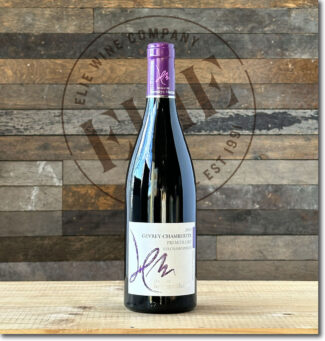 Bottle 2 • Premier Cru Pack
Bottle 2 • Premier Cru Pack
Domaine Heresztyn-Mazzini, 2014 Gevrey-Chambertin Premier Cru Champonnets ($120)
Champonnets is a Premier Cru climat just south of Gevrey-Chambertin on the northern edge of the Grand Cru hillside. Wines from this 8-acre vineyard tend to be less robust than others from the area, displaying silkier tannins, due in part to the northeasterly aspect where the cold winds that flow through the Combe de Lavaux gives Champonnets a cooler mesoclimate than the more sheltered Grand Cru sites that face southeast on the other side of the hill. While vines still have sufficient sunlight during the growing season to develop good sugars and acidity, the grapes lack the concentration of warmer, sunnier climats. Still, the high proportions of limestone is well-suited to the Pinot Noir that grows here, storing sufficient water for hydration while also providing plentiful drainage. The wine shows dried fruit and warm leather on the bouquet along with a slightly smoky palate and a chamois texture from the tannins.
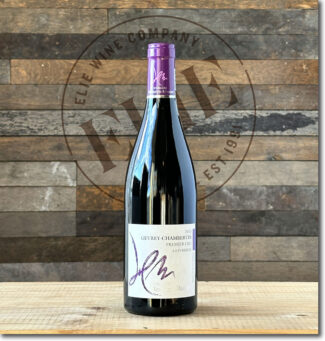 Domaine Heresztyn-Mazzini, 2014 Gevrey-Chambertin Premier Cru La Perrière ($120)
Domaine Heresztyn-Mazzini, 2014 Gevrey-Chambertin Premier Cru La Perrière ($120)
La Perrière runs adjacent to the Mazis-Chambertin Grand Cru, separated only by a dirt path. The vineyard’s name refers to its former occupation as a quarry, and as might be expected, there is a pronounced minerality to wines that bear this designation. Soil from the surrounding area was used to fill in the quarry and this light, loamy topsoil is underscored by free-draining calcareous stones. This elegant and solid-state wine could easy withstand another half-decade in the cellar, but for now it shows perfume of wood, and sous bois with a mineral-inflected finish shaped by impressively fine-grained tannins.
Domaine Odoul-Coquard
Sébastien Odoul—whose name should never be associated with that non-alcohol beer from Anheuser Busch (!) cut his winemaking teeth at Domaine Dujac, Mommessin, and Domaine Denis Mortet. In 2004, he returned to the family domain to join his parents, Sylvette and Thierry, and as of 2009, he took over the estate as vigneron.
In all, the family farms 25 acres in 21 different appellations throughout the Côte de Nuits; most notably, they own the majority of the lieu-dit vineyard of Les Crais Gillon in Morey-Saint-Denis. All of their farming is done with ‘lutte raisonnée’, a sustainable viticulture practice.
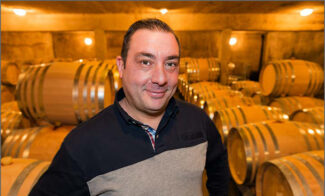
Sébastien Odoul, Domaine Odoul-Coquard
Discussing his different properties, Odoul says, “Morey-Saint-Denis is about fruit and finesse. Not as much finesse as Chambolle-Musigny though. The tannins are more supple than in Gevrey-Chambertin. Basically one could say that Morey-Saint-Denis is like a blend of Chambolle and Gevrey. When it comes to the fruit it is more Chambolle in character, while the tannins are more well-integrated, as in Gevrey.”
After bottling, Odoul gives a third of the result to the commune, explaining, “We have had this arrangement since 1988. My father was the grower in the village with the least amount of Premier Cru vineyard, so they let him have the Clos la Riotte. Since we are not the owners we can’t say it’s a monopole. The commune sells its part with a different label.”
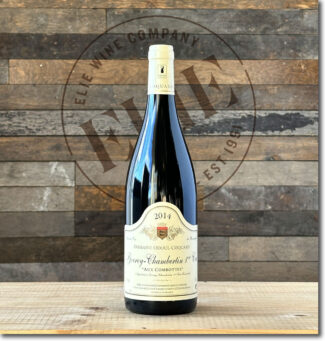 Bottle 3 • Premier Cru Pack
Bottle 3 • Premier Cru Pack
Domaine Odoul-Coquard, 2014 Gevrey-Chambertin Premier Cru Aux Combottes ($140)
12-acre Aux Combottes is Gevrey-Chambertin’s southernmost Premier Cru climat, sitting on the border with Morey-Saint-Denis. The terroir is not quite as high-quality as the Grand Cru vineyards which surround it, but it is certainly one of Gevrey-Chambertin’s top Premier Cru sites. In fact, in the hands of top producers, Combottes can outperform other Premier Crus and some lesser Grand Crus—it’s primary (and perhaps only) drawback is that it lies in a slight depression that funnels cold westerly winds over the vines during the growing season, making complete ripening a challenge. This wine is drawn from three vine ages; according to Sébastien, they are “10, 25 and ‘very old.’” Having seen 75% new oak, wood spice remains to shore up the middle palate of dried strawberry and cedar, but has by now taken a back seat.
Domaine Bernard Dugat-Py
Dugat-Py flies a bit under the radar in Gevrey, possibly overshadow by or confused with Domaine Claude Dugat. Same family, different property.
Located at the base of the Combe de Lavau, Dugat-Py has been producing world-class wines since its founding. The aging cellar forms the focal point of the domain’s architecture; L’Aumôneri, is essentially a small abbey that was built by the Diocese of Dijon in the 11th century, making it the oldest cellar in Burgundy today.
Bernard Dugat purchased the Gevrey vines that produced his first wines in 1975; Py is the maiden name of Bernard’s wife, Jocelyne. In 1996, their son Loïc joined the family business and is now at the helm. He was instrumental in starting their conversion to organic viticulture, for which they gained full accreditation in 2003.
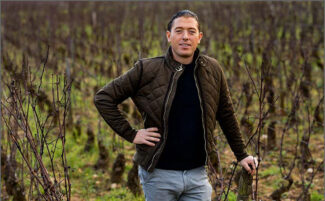
Loïc Dugat-Py, Domaine Dugat-Py
Loïc is passionate about old vines, always searching for old parcels of Pinot Fin or Chardonnay. This dedication has resulted in the domain now owning vines that range from 65 to more than 100 years old in Côte de Nuits and Côte de Beaune. Consequently, nearly every wine in the line-up is designated either as Vieilles Vignes or Très Vieilles Vignes. They tend to these mature vineyards with meticulous care, using homemade biodynamic teas throughout (they are certified biodynamic). The Premier Cru and Grand Cru sites are horse-plowed. The vines are never trimmed, allowing the canopies to reach a height of seven or eight feet in the summer months.
Loïc says, “Today our climats include 23 acres of Pinot Noir and 3 acres of Chardonnay, including the original vineyards located in Gevrey. We have always produced classic Vins de Garde, deep in color, with explosive fruit and chiseled tannins. I refuse to chaptalize, acidify, inoculate or add anything to juice; sulfur is only added prior to bottling. And while the wines are still deep and powerful, I like to think they have more balance and finesse than ever. Also never elevated, the alcohol rarely surpasses 13.5%, and harvest now occurs on the earlier side to retain freshness and elegance.”
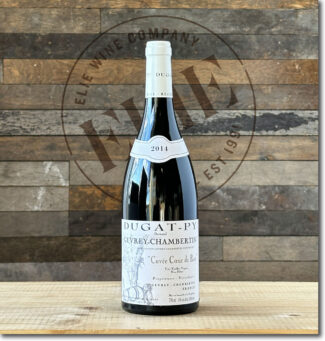 Domaine Dugat-Py ‘Cuvée Cœur de Roy, Très Vieilles Vignes’, 2014 Gevrey-Chambertin ($170)
Domaine Dugat-Py ‘Cuvée Cœur de Roy, Très Vieilles Vignes’, 2014 Gevrey-Chambertin ($170)
From tiny-yield vines ranging in age from 50 to 105 years old; the crop level here is just 23 hectoliters per hectare. The wine is a step up in intensity and sweetness from the Évocelles, with size to support its substantial ripe tannins for the past decade. Its once substantial fruit now shows a nice finishing dryness laced with bitter chocolate, sweet leather and pie spice.
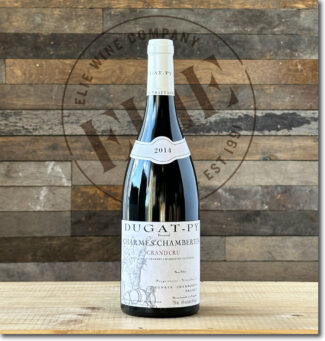 Domaine Dugat-Py, 2014 Charmes-Chambertin Grand Cru ($890)
Domaine Dugat-Py, 2014 Charmes-Chambertin Grand Cru ($890)
A truly brilliant Gevrey; Dugat-Py’s 2014 Charmes-Chambertin was built using around 40% whole bunch fruit, and remains blessed with a rich bouquet with layers of macerated fruit mixed with a retaining-wall of new oak. The palate is dry on the entry and shows granular tannin as a touch of orange rind with a spice note towards the structured finish that is Mazoyères-like in style.
Domaine Bart
Fifteen years ago, the winegrowers of Marsannay started the process of having part of the appellation upgraded to Premier Cru. At Domaine Bart, which produces as many as nine different Marsannay bottlings in a given vintage, it is believed that 25% and 30% of the appellation is up for this bump upstairs. Pierre Bart, the sixth generation to run Domaine Bart, says, “We are trying to show which climats would be of interest and which ones should remain in the village appellation. My guess is that there will be five or six Premier Crus. probably the largest ones like Champs Perdrix, Champ Salomon, Clos du Roi, Longeroies and Montagne.”
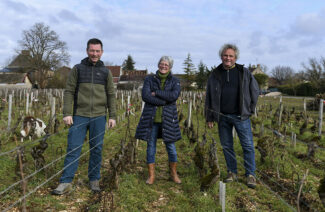
Pierre Bart and Family, Domaine Bart
The Bart domain covers 54 acres, mostly in Marsannay, but with a few parcels in Fixin, Gevrey-Chambertin, Chambolle-Musigny and Santenay. “My grandmother comes from the same family as Domaine Bruno Clair,” explains Pierre Bart. “Part of the vines come from that side of the family, part from my grandfather’s side. The Bonnes Mares and the Chambertin Clos de Bèze mainly come from my grandmother. 35 years ago, when my uncle arrived at the domain, the style of the wines changed. He increased the size of the holding, mainly in Marsannay. He chose to improve quality, both in terms of equipment and in winemaking. Since then we haven’t changed our vision a single iota.”
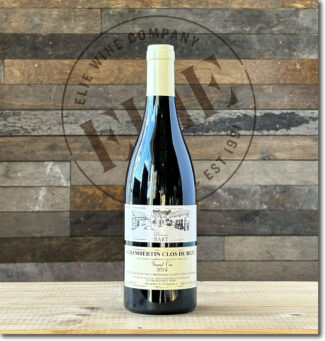 Domaine Bart, 2014 Chambertin Clos de Bèze Grand Cru ($550)
Domaine Bart, 2014 Chambertin Clos de Bèze Grand Cru ($550)
Clos-de-Bèze may be almost as highly regarded as its southern neighbor Chambertin, whose soils are similar, made up of pebbly, free-draining limestone with a good proportion of clay. Like Chambertin, Bèze makes a wine that is classically Gevrey-Chambertin—perfumed, full-bodied, concentrated and structured, and worthy of being aged for many years. Appellation law allows producers to label wines from Clos-de-Bèze as Le Chambertin (but not the other way around), and while the latter is often considered the apogee of Gevrey-Chambertin, Clos-de-Bèze is the older of the pair. Records show the vineyard, owned and run by the Abbey of Bèze, was already known in the 7th Century, well before it was ceded to the Chapter of Langres, which by that stage had acquired Mr. Bertin’s field, ‘le champ de Bertin’ in the 12th Century.
Believing that his Clos de Bèze tends to taste almost too ready to drink at bottling, Pierre Bart ends fermentation by raising the temperature and giving the wine a couple of powerful punch-downs to fix a bit more tannin. The 2014 may still be in its late youth, showing concentrated, almost brûlée-like blackcurrant, cherry compote and an overflowing spice-box behind a velvety expression where licorice and chocolate come into play alongside musk, truffle and forest floor.
- - -
Posted on 2024.01.06 in France, Champagne, Wine-Aid Packages | Read more...
Producer Of The Year: The Talented Aurélien Laherte ‘Quest For The Perfect Alchemy’
Sparklers To Ring In The New Year
This week (like many of you) we mark the arrival of a new year with the wine style most associated with celebration: Effervescent. At Elie’s, this bubbly occasion is the culmination of a year spent like a cat with a laser pointer as we chase down the best sparkling wines of France and Spain, ending up in familiar appellations in Champagne and some finding off-the-beaten path gems in terroirs where Méthode Champenoise may not be the first words that come to mind. In Alsace, for example, Domaine Valentin Zusslin produces a textbook-perfect Crémant using pure Bollenberg Pinot Noir, while Domaine Michel Briday’s sparkling Burgundy hails from 38 acres spread across the municipalities of Rully, Bouzeron and Mercurey. In Spain, amid the unblemished beauty of the Penedès, Pepe Raventós brainchild winery Can Sumoi has captured the smells and flavors of Catalunya in his remarkable portfolio of pétillant and sparkling.
With season of sparkles fully upon us, we will cap the year in our usual fashion—by showcasing the wines of a particularly interesting producer. This year, the talented Aurélien Laherte from Champagne Laherte Frères gets the nod, offering us an array of Coteaux Sud d’Epernay gems that have raised the quality bar in this somewhat lesser-known of Champagne’s 7 ‘regions’, the spiritual home of Meunier. Aurélien also experiments with some of Champagne’s nearly forgotten varietals and is lauded for his attention to lieu-dit expression as well as his mastery of the fine art of blending.

Champagne Laherte Frères
Champagne’s Coteaux Sud d’Epernay
Terroir Fundamentals: Preserving Its Details
When trying to demystify the mysterious—and to ground the ethereal—words like ‘alchemy’ (the ancient pseudoscience of spinning gold from base metals) may seem problematic. And yet, under the nimble hands of Aurélien Laherte, the full range of Champagne’s ‘next-level’ magic takes center stage.
‘Next-level’ because Laherte is one of the most progressive young winemakers in the Coteaux Sud d’Epernay, a sub-region sandwiched between the Côtes des Blancs and the Vallée de la Marne. A champion of organics and biodynamics, Aurélien produces a lineup of blended and single-vineyard Champagnes that expresses the unique identities of his terroirs.
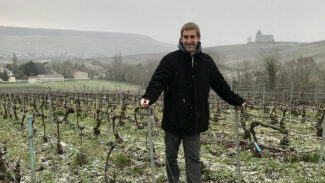
Aurélien Laherte, Champagne Laherte Frères
The quest for perfection is a keystone in the plans of every winemaker, but in Champagne, where warming temperatures are created consistently better harvests and a return to a natural approach is making terroir more and more transparent; the luck of the draw is shifting to the skills of the Cellar Master. Knowing when to blend and when to let an individual lieu-dit shine through is among the most valuable tools in the chest, and when deployed correctly, allows the vintner to create wines worth their weight in gold.
The result is clear, chiseled Champagnes that are created with the sole intention of reflecting the nuances of the plot in which they originate. The estate, with 75 parcels situated in three distinct areas (the southern slopes of Épernay, the Côte des Blancs, and the Marne Valley) is centered in the village of Chavot in the Côteaux Sud d’Epernay. They produce around 150,000 bottles a year, and this week’s offering contains a cross-section of the most outstanding.
Single Variety
Champagne’s Nod To Burgundy
Bordeaux, and indeed much of Champagne, blends grape varieties to create signature ‘house’ wines. In Burgundy, the thinking is different: Burgundies are primarily monocépages, meaning they are made from a single grape variety, often sourced from a single vineyard. In Bordeaux, the monocépage concept is virtually unknown, but in Champagne, most prominent producers will offer at least one or two in their portfolio, Blanc de Noirs or Blanc de Blancs. Frequently they are vintage cuvée produced only in years where a special set of conditions are met and only released in limited quantities.
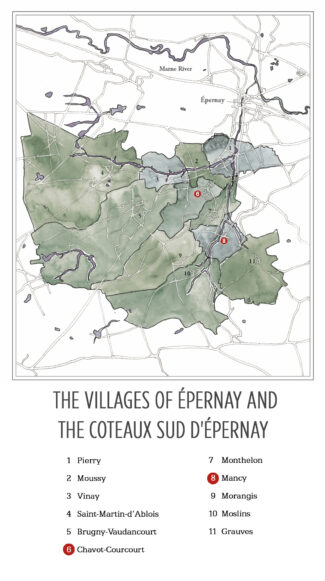
• Blanc de Blancs
Blanc de Blancs—a term found only in Champagne—is used to refer to Champagne produced entirely from white grapes, most commonly Chardonnay. Pinot Blanc and Petit Meslier can also be used, as well as a number of other varieties permitted in the appellation, but these are much less common.
Chardonnay: ‘Emblematic Cuvée’
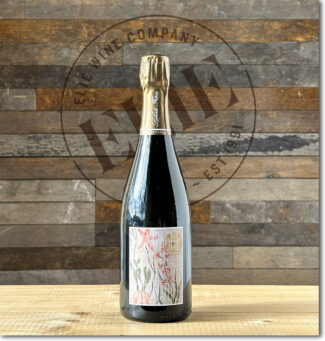 Champagne Laherte Frères, Coteaux-Sud-d’Epernay Blanc de Blancs Brut Nature ($59)
Champagne Laherte Frères, Coteaux-Sud-d’Epernay Blanc de Blancs Brut Nature ($59)
100% Chardonnay from the south-facing slopes of Épernay and Chavot, grown on soft clay and chalk and harvested from vines about 35 years old. The wine is fermented in small foudres and barrels with minimal bâtonnage; it undergoes partial (20%) malolactic and is aged on fine lees prior to disgorgement. The zero dosage is balanced by the creaminess of the malo; the wine shows bright tropical fruit flavors, especially mango with a hint of ginger. Disgorged January 2023.
Chardonnay: ‘White with A View’
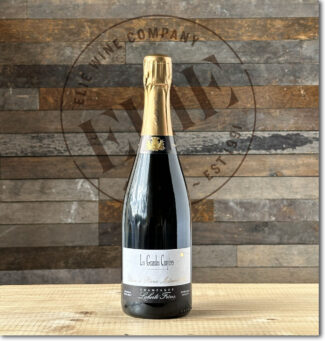 Champagne Laherte Frères, 2019 Coteaux-Sud-d’Epernay Chavot ‘Les Grandes Crayères’ Blanc de Blancs Extra-Brut ($91)
Champagne Laherte Frères, 2019 Coteaux-Sud-d’Epernay Chavot ‘Les Grandes Crayères’ Blanc de Blancs Extra-Brut ($91)
100% Chardonnay from Chavot mid-slopes where soft Campanian chalk gives these old vines a perfect substratum on their western exposition. This is a single-vineyard cuvée with vines grown using sélections massales and a blend of new and old rootstocks. Disgorgement is done by hand, with dosage at 3 gram/liter. A classic Coteaux Sud Blanc de Blancs showing notes of crème brûlée, apple pie, Jerez-like nuttiness and an extremely fine mousse. Disgorged November 2022. 3928 bottles produced.
Petit Meslier: ‘Vibrant and Expressive’
Petit Meslier is a nearly-forgotten grape of which Laherte is so enamored that he replanted a portion of the clay and silt (with chalk below) mid-slope in the hills of Chavot to preserve the varietal diversity of Champagne. Don’t confuse Meslier with the similar-sounding Meunier; it is a white grape made by crossing Gouais Blanc with Savagnin. Currently grown in small quantities in Champagne, it is noted for its heat resistance and ability to maintain acids during long spells of hot weather and, when vinified as a monocépage, provides tremendous aromatic intensity and depth.
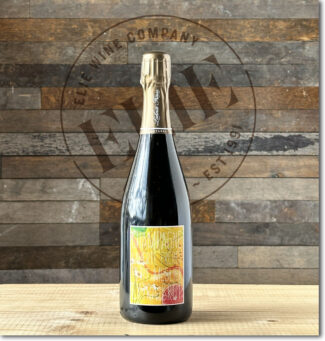 Champagne Laherte Frères ‘Petit Meslier’, Coteaux-Sud-d’Epernay Extra-Brut ($130)
Champagne Laherte Frères ‘Petit Meslier’, Coteaux-Sud-d’Epernay Extra-Brut ($130)
100% Petit Meslier. In creating his iconic, all-inclusive blend ‘Les 7’, Aurélien was particularly struck by the ability of his Petit Meslier to stand on its own. From a vineyard called ‘Cépage Oubliés’, it is a blend of several harvests with 40% reserve wine and aged for six months on its lees ‘fût de chêne’, or in oak barrels; it shows honeyed pear, buttered toast and toasted almonds behind an unsurprisingly racy spine of acidity. Disgorged September 2022.
• Blanc de Noirs
In Champagne, Blanc de Noirs mean that the wine is made from either Pinot Noir or Meunier (or a blend of the two), although it’s relatively common to find 100% Pinot Noir. Despite the ‘Noir’, they may be notably ‘Blanc’ since both Pinot Noir and Meunier are red skinned, white-fleshed grapes that produce clear juice. Without being given time to macerate on the dark skins, the wine will be white to the eye, though much more to the palate.
Meunier: ‘Celebrating the Variety’
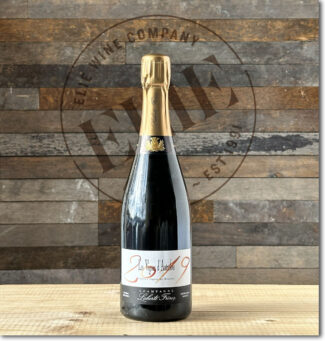 Champagne Laherte Frères ‘Les Vignes d’Auterfois – Vieilles Vignes de Meunier’, 2019 Coteaux-Sud-d’Epernay Extra-Brut ($91)
Champagne Laherte Frères ‘Les Vignes d’Auterfois – Vieilles Vignes de Meunier’, 2019 Coteaux-Sud-d’Epernay Extra-Brut ($91)
The selected Meunier plots for this wine were planted by the Laherte family between 1947 and 1953 in the villages of Chavot (lieux-dits La Potote and Les Rouges Maisons) and Mancy (lieu-dit Les Hautes Norgeailles). Some of the vines were planted on French rootstock while others are the result of old sélection massale. Aurélien uses traditional wooden Coquard presses; fermentation occurs with native yeast in old Burgundy barrels and malolactic fermentation does not take place. The wine ages up to 19 months on the lees and dosage is between two and four grams per liter; it exhibits marvelous aromas of white peach, violets and verbena. Disgorged November 2022. 4396 bottles produced.
Pinot Noir: ‘Deep and Faithful’
Pinot Noir accounts for 38% of the area under vine in Champagne and is the dominant grape in Montagne de Reims and Côte des Bar. It is frequently referred to as ‘Précoce’ due to its tendency to ripen early, leaving behind the acidity so prized by Champagne makers. It thrives in cool, chalky soil—a hallmark of Champagne’s terroir.
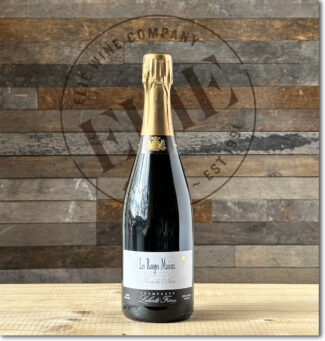 Champagne Laherte Frères, Coteaux-Sud-d’Epernay Chavot ‘Les Rouges Maisons’ Blanc de Noirs Extra-Brut ($91)
Champagne Laherte Frères, Coteaux-Sud-d’Epernay Chavot ‘Les Rouges Maisons’ Blanc de Noirs Extra-Brut ($91)
100% Pinot Noir (harvest 2019) from the prized lieu-dit Les Rouges Maisons planted in 1983 on rich soils of silex, schist and limestone. Malolactic is employed and dosage a scant 2 grams per liter to produce a rich BdN, poised on the palate and showing the austerity, finesse and racy freshness typical of this terroir. Disagorged November 2022. 1698 bottles produced.
Pinot Noir: ‘Intense and Straight’
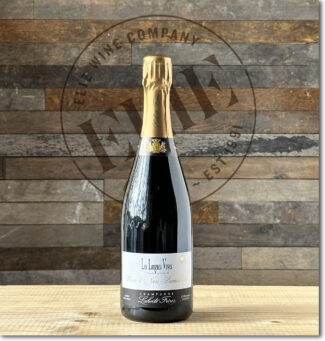 Champagne Laherte Frères, 2019 Montagne-de-Reims Premier Cru Chamery ‘Les Longue Voyes’ Blanc de Noirs Extra-Brut ($91)
Champagne Laherte Frères, 2019 Montagne-de-Reims Premier Cru Chamery ‘Les Longue Voyes’ Blanc de Noirs Extra-Brut ($91)
Part of Aurélien Laherte’s’ ‘Terroirs’ series, this is the second incarnation of ‘Les Longue Voyes’, a Blanc de Noirs Champagne made entirely from Pinot Noir. The fruit comes from the village of Chamery on the Petite Montagne de Reims, nearly twenty miles from the estate—hence the name, which means ‘The Long Way’. Barrel aged for 18 months with a 4 grams per liter dosage and no malolactic, the nose reveals notes of black fruits, and the palate is tense, tasty and tonic with a persistent saline finish. Disgorged November 2022. 3274 bottles produced.
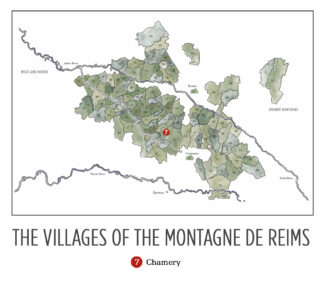
• Rosé
Credit Madame Clicquot for revolutionizing the (then) relatively small production of pink Champagne. A believer in the idea that a wine should flatter both the eye and the palate, the Grande Dame broke with tradition and re-created the process of making rosé champagne. Before, it was made by adding an elderberry-based mixture to white Champagne, but Madame Clicquot had vines in the Bouzy region of Champagne where she made her own red wine, and she decided to blend this with her still white wines.
This is the most common method of producing rosé Champagne—blending clear white and black grape musts, using between 5% and 15% red wine; it is called a rosé of ‘assembly’. The proportion of red wine can vary, but the white wine must be the majority. Another method of rosé production is the ‘saignée’ method, which involves allowing the must to undergo minimal skin contact, generally for only a couple of hours. This minimal maceration allows the must to develop stronger aromas and flavor profiles while deepening the color. ‘Saignée’ translates literally to ‘bleeding’, which is essentially what the skins are doing into the juice.
Meunier: ‘Strong Identity’
Traditionally used as a blending grape, there are about 26,000 acres of Meunier planted in Champagne, and the variety is rapidly becoming more than an afterthought used for color and balance. In the right soil conditions (calcareous clay with deeper chalk layers) and if allowed to ripen well (leapfrogging the vegetal stage) it can produce a wine that ages remarkably, showing finesse and freshness even after years in the bottle.
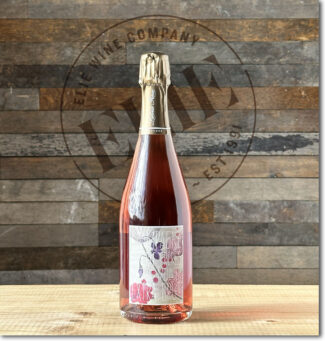 Champagne Laherte Frères ‘Rosé de Meunier’, Extra-Brut Rosé ($61)
Champagne Laherte Frères ‘Rosé de Meunier’, Extra-Brut Rosé ($61)
100% Meunier, the wine is sourced from vineyards in the Vallée de la Marne and Chavot with an average age of 25 years for the Meunier vinified white and more than 40 years for the parcels selected for the red wine. It is a blend of 30% macerated Meunier, 60% white wine from Meunier and 10% still red Meunier. As a result, it uses both methods of Champagne rosé creation, assemblage (blending) and saignée (bleeding). The wine is multi-layered with a ripe core of red fruit and brisk girdling acids. Disgorged March 2023.
Meunier: ‘Varietal Complexity and Nuances’
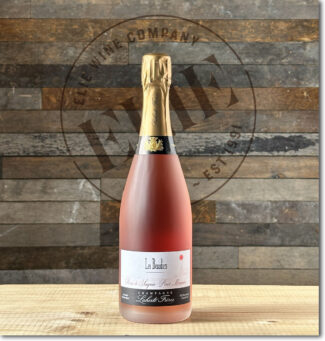 Champagne Laherte Frères, Coteaux-Sud-d’Epernay Chavot ‘Les Beaudiers’ Extra-Brut Rosé de Saignée ($91)
Champagne Laherte Frères, Coteaux-Sud-d’Epernay Chavot ‘Les Beaudiers’ Extra-Brut Rosé de Saignée ($91)
Produced entirely from Meunier (harvest 2019) which comes from plots situated in ‘Les Beaudiers’ in Chavot and cultivated using methods which include short pruning for a limited production; manual and painstaking work that requires regular plowing. The grapes were destemmed and macerated for twelve hours, then fermented in barrels on natural yeast without malolactic. The wine shows layers of pomegranate, wild strawberry and rose petals above an exquisite bead and all the depth and density one expects in a saignée. Disgorged November 2022. 1672 bottles produced.
Blending
A Tapestry Of Few Threads
Champagne should illustrate the word ‘synergy’ above all, where the sum of the total is greater than the individual parts. The ideal blend should be the aggregation of positive components; every thread should add to the tapestry’s whole. The blend should always drive toward harmony; Chardonnay is often up front, while Pinot Noir supplies the middle and finish. Other allowable varietals should only appear if they contribute to the primary blend.
This is not a universal outcome, of course, and according to Jean-Marc Lallier of Champagne Deutz, “Some winemakers do not blend; they mix.”
When cellar masters do it right, it is a painstaking undertaking; every tank, barrel and vat is tasted countless times to assess which batch would enhance which. This is the true art of Champagne making—the intimate familiarity with each component in order to align them perfectly.
At Laherte, Aurélien does not have a recipe for a single wine; he blends according to the call from the barrel and each blend has a trademark distinction. He prefers very low dosage, insisting that the wine’s minerality must speak first. Regarding the tedious art of blending, he says, “They’re like people; one needs to be strong, one of them weak; one bitter, one elegant.”
Highlighting Village Chavot’s Terroir: Diversity Of Soil
The commune of Chavot-Courcourt consists of Chavot (in the northeastern part of the commune) and Courcourt (in the central part of the commune), but also the small villages Ferme du Jard, Les Fleuries, La Grange au Bois, and Le Pont de Bois. Among the many folds and hills in the area, the upper reaches are clay-dominant while the soils turn chalkier as you descend. Most of the vineyards in Chavot-Courcourt are located in the northern part of the commune, on slopes formed by the stream Le Cubry.
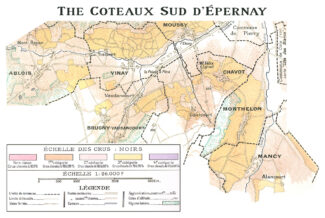
Aurélien Laherte explains why he farms so many individual parcels in a relatively small area: “Below the village especially is a significant difference in soil types. I have identified 27 terroir-types in Chavot-Courcourt alone and farm 45 parcels. There is no sand, but there is virtually everything else—from chalk to clay to limestone. Between them are countless fine-grained distinctions, so I treat them individually and vinify them separately.”
Les Beaudiers is a vineyard in Chavot where Laherte Frères has old vines of Pinot Meunier (planted in 1953, 1958, and 1965) that are used for a rosé saignée. Other vineyard sites in Chavot-Courcourt include Les Charmées, Les Chemins d’Epernay, Les Monts Bougies, Les Noelles, La Potote, and Les Rouges Maison, all used by Laherte Frères for their Champagnes Les Vignes d’Autrefois and Les Empreintes.
Although Meunier is the dominant grape variety, Laherte also owns a vineyard called ‘Les Clos’ where he plants all seven legally allowable Champagne grape varieties. From this he concocts the individual-vinification philosophy by picking and pressing all seven varietals together.
‘Duality of Terroir’
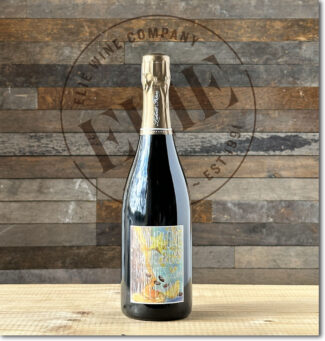 Champagne Laherte Frères ‘Les Empreintes’, 2017 Coteaux-Sud-d’Epernay Chavot Extra-Brut ($99)
Champagne Laherte Frères ‘Les Empreintes’, 2017 Coteaux-Sud-d’Epernay Chavot Extra-Brut ($99)
From two parcels in the Chavot lieux-dits Les Chemins d’Épernay and Les Rouges Maisons, each (in Aurélien’s words) ‘exemplifying the quintessence of the Chavot terroir.’ The wine is a classic Champagne blend, half Chardonnay, (of which one-third is Chardonnay Muscaté) from Les Chemins d’Epernay where there are clay soils with a little silt stratum in surface and a chalky subsoil—vine planted in 1957. The other half is Pinot Noir from Les Rouges Maison where the soil is fairly deep with a vital presence of clay, flints and schists; these vines were planted in 1983. With a dosage of 3.5 grams per liter, it is a resonant Champagne with floral top notes and deftly balanced acidity. Disgorged October 2022.
‘Infusion’
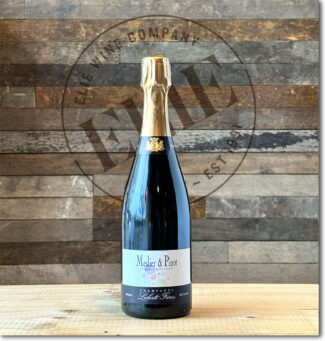 Champagne Laherte Frères ‘Infusion – Meslier & Pinot’, Coteaux-Sud-d’Epernay Chavot Brut Nature ($150)
Champagne Laherte Frères ‘Infusion – Meslier & Pinot’, Coteaux-Sud-d’Epernay Chavot Brut Nature ($150)
Only 600 bottles were made of this tiny cuvée. The blend is 50% Petit Meslier and 50% Pinot Noir from two plots in Chavot, and it spends 30 months on the lees in barrel before being bottled without dosage. True to its name, the crisp fruit of Meslier is infused with Pinot Noir’s vinosity, and the wine shows green apple, citrus peel, almond and stone flavors that linger through a long, nicely balanced finish. Disgorged October 2022. 669 bottles produced.
‘Tribute to Yesterday’s Wines’
The soléra system of maturation used for Sherry, the famous fortified wine of Jerez, is a cry for consistency from vintage to vintage. The system involves removing wine for release from the last of a series of barrels that contains a blend of every vintage since the soléra was started. The void in those barrels is then filled with wine from another series of barrels, and so on, until there is room in the youngest series of barrels. The wine from the most recent vintage is added to those barrels.
In Champagne, the method used is slightly different; after each harvest, wine is added to the blend, and every time a producer is ready to release a new batch of non-vintage Champagne, he removes what he needs. Over time, the cuvée becomes increasingly complex as the fresh wines of the latest vintage taking on the mature qualities of those that came before it. It is a system used by surprisingly few producers in Champagne, but Laherte Frères is one of them.
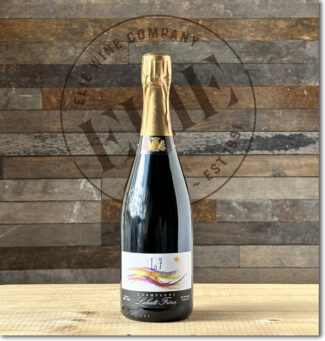 Champagne Laherte Frères ‘Les 7 Soléra’, Coteaux-Sud-d’Epernay Chavot Extra-Brut ($130)
Champagne Laherte Frères ‘Les 7 Soléra’, Coteaux-Sud-d’Epernay Chavot Extra-Brut ($130)
As the name suggests, all seven allowable Champagne grapes are used in this single cuvée; 10% Fromenteau, 8% Arbane, 14% Pinot Noir, 18% Chardonnay, 17% Pinot Blanc, 18% Meunier and 15% Petit Meslier from a vineyard planted by Thierry Laherte in 2003. He picks and presses all seven together and employs his perpetual cuvée: Les 7 contains wine not only from the current vintage, but draws bits of reserve wine from all harvests dating back to 2005, the year Aurélien took over the domain. All bottles are disgorged by hand with a dosage of 4 grams per liter. The wine shows lemon zest, crystalline green-apple candy and floral notes in a stony infrastructure. Disgorged November 2021. 3621 bottles produced.
‘Return to Basics’
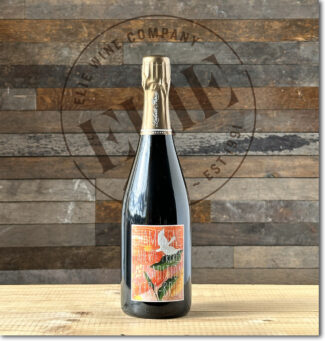 Champagne Laherte Frères ‘Ultradition’, Extra-Brut ($54)
Champagne Laherte Frères ‘Ultradition’, Extra-Brut ($54)
60% Meunier, 30% Chardonnay and 10% Pinot Noir from vineyard plots in the Côteaux Sud d’Epernay, Vallée de la Marne and Côte des Blancs where vines average around 30 years. The wine ages in barrels for six months and given light filtration before bottling during the spring time; 6-8 gr/l dosage. The wine offers a complex bouquet of dried apple and toasted walnut; the Meunier lends floral tones and an upper-register smokiness. Disgorged September 2022.
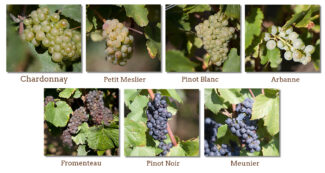
Coteaux-Champenois: Still Champagne
Is It Still Champagne?
The Coteaux-Champenois AOP is dedicated entirely to non-effervescent wine from Champagne and may be red, white or rosé, although the lion’s share is red—Bouzy rouge being the most celebrated. With a warming climate ripening grapes more consistently, Coteaux-Champenois is becoming positively trendy and producers across the 319 communes entitled to make wines under the Coteaux Champenois appellation.
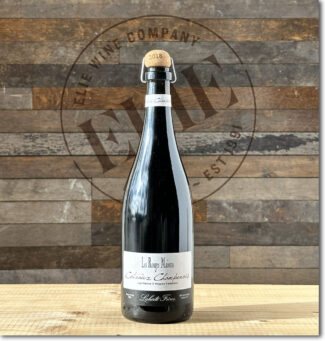 Domaine Laherte Frères, 2018 Coteaux-Champenois ‘Les Rouges Maisons’ Rouge ($73)
Domaine Laherte Frères, 2018 Coteaux-Champenois ‘Les Rouges Maisons’ Rouge ($73)
100% Pinot Noir from the prized Les Rouges Maisons lieu-dit; Aurélien says. “At the domain, we love diversity and we have a naturally curious and imaginative winegrower spirit! After a few years, we are happy to be able to present some Coteaux Champenois to you again. In 2018, the harvest was beautiful, generous, with maturities rarely reached and with a full and intense aroma. It seemed obvious to us to push the maturities on a few plots, in order to seek phenolic maturity and an interesting structure to develop Coteaux-Champenois.”
The wine shows off the chalky terroir in a mineral-driven Pinot Noir filled with the finesse and tension that reflects true Champagne character. Only 854 bottles were made.
Notebook
The Coteaux Sud d’Épernay: Middle Grounds, Between Two Giants
The Coteaux Sud d’Épernay is Meunier-rich, with 47% of its 3000 acres planted to this variety, which is sometimes imagined as an ‘also ran’ in Champagne. In fact, Meunier is suited for soils that contain more clay and in terroirs with harsher climatic conditions since it buds late and makes it more resistant to frost. Sandwiched between the powerhouse wine regions Côte des Blancs and Vallée de la Marne, the Coteaux has an identity removed from either one; its terroir is distinctly different from the clay-heavy soils of the Marne and lacks the chalk of that puts the ‘blanc’ in the Côte des Blancs.
Phrasing it succinctly is Laherte Frères proprietor Aurélien Laherte: “Our wines show more clay influence than those of the Côte des Blancs and they are chalkier than the wines of the Vallée de la Marne.”
In short, these Champagnes are uniquely situated to offer the best of both worlds. As a result, the Coteaux Sud d’Épernay has long fought for recognition as entity unto itself, not necessarily a sub-region of its big brothers on either side.
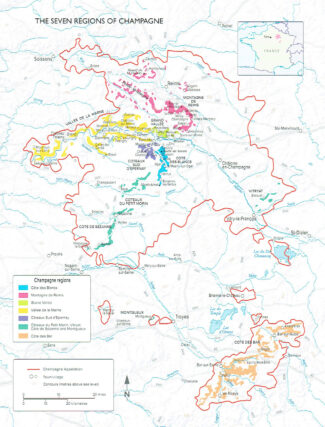
Drawing The Boundaries of The Champagne Region
Having been defined and delimited by laws passed in 1927, the geography of Champagne is easily explained in a paragraph, but it takes a lifetime to understand it.
Ninety-three miles east of Paris, Champagne’s production zone spreads across 319 villages and encompasses roughly 85,000 acres. 17 of those villages have a legal entitlement to Grand Cru ranking, while 42 may label their bottles ‘Premier Cru.’ Four main growing areas (Montagne de Reims, Vallée de la Marne, the Côte des Blancs and the Côte des Bar) encompass nearly 280,000 individual plots of vines, each measuring a little over one thousand square feet.
The lauded wine writer Peter Liem expands the number of sub-regions from four to seven, dividing the Vallée de la Marne into the Grand Vallée and the Vallée de la Marne; adding the Coteaux Sud d’Épernay and combining the disparate zones between the heart of Champagne and Côte de Bar into a single sub-zone.
Lying beyond even Liem’s overview is a permutation of particulars; there are nearly as many micro-terroirs in Champagne as there are vineyard plots. Climate, subsoil and elevation are immutable; the talent, philosophies and techniques of the growers and producers are not. Ideally, every plot is worked according to its individual profile to establish a stamp of origin, creating unique wines that compliment or contrast when final cuvées are created.
Champagne is predominantly made up of relatively flat countryside where cereal grain is the agricultural mainstay. Gently undulating hills are higher and more pronounced in the north, near the Ardennes, and in the south, an area known as the Plateau de Langres, and the most renowned vineyards lie on the chalky hills to the southwest of Reims and around the town of Épernay. Moderately steep terrain creates ideal vineyard sites by combining the superb drainage characteristic of chalky soils with excellent sun exposure, especially on south and east facing slopes.
- - -
Posted on 2023.12.30 in Coteaux Champenois, France, Champagne, Wine-Aid Packages | Read more...
Benoît Marguet’s Naturally Grown Champagne Channels His Biodynamic & Homeopathic Practices
True disciples call it wine’s inevitable future, and even the naysayers are beginning to admit that after years of practicing biodynamics, the dividends are irrefutable. And nowhere in Champagne is this more evident than at Champagne Marguet, where Benoît Marguet is one of the few growers in the region to have thrown himself, both body and soul, vineyard and cellar, into homeopathy.
It’s easy to think of Champagne as a spiritual substance; after all, it was created by monks and the very airiness of its identity seems celestial. The cornerstone of biodynamics is a view of the vineyard, and its subsequent produce, in like terms—as a singular organism capable of self-healing and self-propagation. Natural material alone sustains the soil; chemical fertilizers and pesticides are forbidden and instead, a range of animals are encouraged to create a rich, fertile environment in which the vines can thrive.
For Benoît Marguet, this goes beyond biodynamics as a concept; it’s a vision of complete harmony in every stage of winemaking and an improvement in his own personal life which translates into his Champagne.
The Montagne de Reims: A Sea Of Pinot Noir
Forming a broad and undulating headland that covers five thousand acres of thicket and vineyard, the Montagne de Reims stretches 30 miles east to west and, north to south, is about five miles wide. The vines hug the limestone slopes of the western and northern flanks and are planted in a huge semicircle that extends from Louvois to Villers-Allerand.
This is Pinot Noir country (except in Trépail and Villers-Marmery, where the Chardonnay can be found). The most northerly of Champagne’s four demarcated regions, the Montagne de Reims is also the most well-known, with more Grand Cru sites than anywhere else in the AOP. Tectonics gave the region mountains of chalk, and the Romans added their two cents by leaving behind huge limestone pits known as crayères. Within, the humidity remains at around 60% and temperatures at a steady 57°F; perfect cellaring conditions to soften the cold-climate acids of Champagne with time on lees. As a result, Louis Roederer, Ruinart, Veuve Clicquot, Krug, Taittinger and Mumm all store wine here.
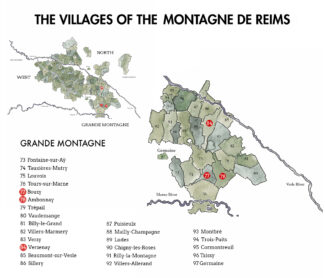
Champagne Marguet
“A Vitality About The Fruit That Makes It Feel Truly Alive.”
Champagne Marguet has been a bellwether for innovation since 1883, the year that Émile Marguet began to graft his vines onto American rootstocks in the face of the impending invasion of phylloxera. Alas, so ridiculed was the notion throughout Champagne that Marguet wound up tearing out the grafted vines and promptly declared bankruptcy.
Ratchet forward a century and a half: In 2006, Émile Marguet’s distant scion Benoît Marguet joined forces with Hervé Jestin, the former chef de cave of Duval-Leroy, and began to produce a special homeopathic and biodynamic super-cuvée called ‘Sapience’, first released in 2013. Being on the cutting edge of trends has finally paid dividends.
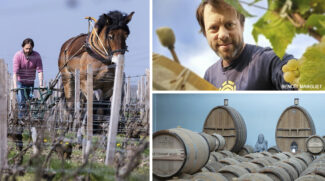
Today, Benoît farms 25 acres of vines, all using biodynamic practices. Most are owned by Marguet himself while the rest are leased from relatives. Among them are eight different lieux-dits with an average vine age of 42 years; each is bottled under the name of the plot and reflects the minute soil differences that exist throughout his holdings as well as the Massale-select varieties he suits to his various terroirs—among them Les Crayères, Les Bermonts, Le Parc and Les Saints Rémys.
The Horses, The Vines and The Eggs
Two techniques keep Benoît Marguet close to his passion; first, since 2009, he has plowed his acres with a pair of draft horses. He argues that by using this method of cultivation roots are forced deeper towards the water table surface, providing a better water supply. In addition, he treats the soil with preparations made of essential oils, tisanes, nettles, citronella, lavender and rhubarb. “The well-being of the soil is a priority,” he points out. “The horse is in connection with the three elements of terroir, the mineral (chalk), the vegetal (vine and flora) and the animal (fauna and human interaction).”
Next, in the cellar, he continues to adhere to the principles of biodynamics by working the wine according to lunar cycles. Under the conviction that the shape of a vat can affect the quality of the wine, he installed special 40-hectoliter egg-shaped wooden cuvée casks produced to his specifications by Tonnellerie Taransaud. The unique shape provides a height/width ratio equal to the Golden Mean or Phi, which Benoît believes is a natural feature repeated throughout the physical world and encourages spiral convection currents and a harmony to better clarify the wine… and his own purpose.
“This symbiosis, with the principle of nature assisting nature, is fascinating research work for me, with influences from various cultures and countries,” Benoît maintains. “In my opinion these fundamental or elemental practices are solutions that instill within our wine its full health benefits, and perhaps even more…”
Blanc de Blancs vs. Blanc de Noirs: Revealing The Fruit
The introductory lesson in Champagne Appreciation 101 is that sparkling wine is made from either light-skinned or dark-skinned grapes, or a combination of both, and all can end up looking a lot the same. This holds especially true in cool-weather climates like Champagne, where vinifying slightly under-ripe grapes is the norm—a point when Pinot Noir and Meunier may not have fully developed their juice-staining anthocyanins. To maintain the desired hue, of course, dark-skinned grapes are pressed gently to keep the skins from bleeding into the juice and the skins separated out quickly.
Holding equally true is the fact that looks can be deceiving. Blanc de Noirs Champagnes made with Pinot Noir and/or Meunier do not share a flavor profile with a Blanc de Blancs made from Chardonnay, and this is the result of both nature and nurture. Generally speaking, a Blanc de Blancs will be a bit lighter and dryer, showcasing the fruits that predominate in Chardonnay’s arsenal—white peach, citrus, green apple and pear. Blanc de Noirs tend to have more body, creamier texture, and the fruit contours are often red; cherry and raspberry, and toasty notes may be more emphatic.
Naturally, the only true lesson in that appreciation course is determining for yourself if you prefer one over the other, and since we are dealing with Champagne, you are more than welcome to respond, “All of the above.”
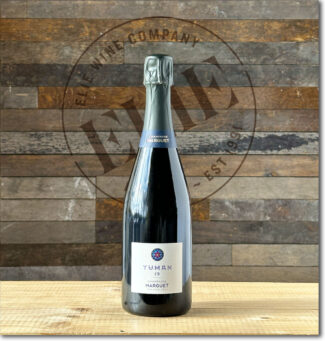 Champagne Marguet ‘Yuman 2019’ Premier Cru Blanc de Noirs Brut Nature D-2/2022
Champagne Marguet ‘Yuman 2019’ Premier Cru Blanc de Noirs Brut Nature D-2/2022
Yuman is a newer project of Benoit’s that uses organic/biodynamic fruit from two producer friends in Champagne. It is not an estate wine, but is treated just like his other cuvées, seeing a natural fermentation in barrel, and 36 months on the lees. Built upon 100% biodynamic-certified Pinot Noir from the Grand Cru village of Verzenay and Premier Cru village of Cumières, it shows a characteristically crisp acidity behind rich raspberry coulis and aromas of freshly-baked graham cracker.
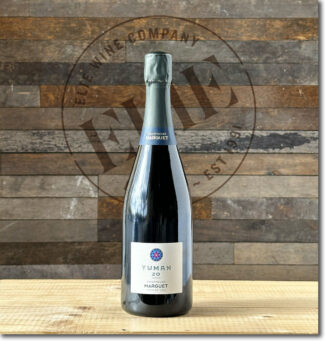 Champagne Marguet ‘Yuman 2020’, Premier Cru Blanc de Blancs Brut Nature D-3/2023 (Sold Out)
Champagne Marguet ‘Yuman 2020’, Premier Cru Blanc de Blancs Brut Nature D-3/2023 (Sold Out)
A cuvée based on the 2020 vintage; 100% organic Chardonnay sourced from Benoît’s friends Premier Crus Villeneuve-Renneville and Villers-Marmery in the Montagne de Reims. The wine is a wealth of intensity with crisp, chalky, mineral notes and perfumed Meyer lemon on the nose and palate.
Grand Cru Bouzy and Grand Cru Ambonnay: Always Rivals
Like the Hatfields and the McCoys (only without rebel flags and shotguns), Bouzy and Ambonnay have a longstanding rivalry built on begrudging respect and competitive moxie. At its closest point, the distance between the two communes is shorter than a long drive with a golf club, and each have shored up a reputation for superlative wines from the south side of the Montagne de Reims hill.
Yet connoisseurs will happily point out their favorite qualities in each, generally citing the special elegance of wines from Ambonnay, due in part to undulating, south-eastern exposures that moderate the ripening process.
In contrast, Bouzy exposures are almost entirely to the south, ideal for Pinot Noir. More than nine hundred acres in Bouzy are under vine, with 87% of them Pinot Noir, 12% Chardonnay and a scant 0.2% Meunier. The most prominent Champagne houses with a Bouzy presence are Bollinger, Duval-Leroy, Moët & Chandon, Mumm, Pol Roger and Taittinger.
Nearby Ambonnay shares a nearly identical terroir with Bouzy and is similarly appointed, although with slightly less Pinot Noir grown and a bit more Chardonnay—white grapes account for about 20% of the vineyards. Like Bouzy, ‘Ambonnay Rouge’ represents a small portion of wine production. Prominent Champagne houses that control Ambonnay vineyards include Duval Leroy, Moët & Chandon, Mumm, Piper Heidsieck, Pol Roger and Roederer.
2018 Vintage: Pinot Noir Ripened Perfectly. Chardonnay Is Outstanding. Climate Change Is Beginning To Make itself Felt.
2018 checked all the boxes for exceptional Vintage Champagne; the Pinot Noir crop ripened perfectly and the Chardonnay harvest created wines that are full-bodied yet fresh and promise to be long-lasting. Icing on the cake is that the vineyards produced copiously
A few isolated hailstorms led to some crop loss, notably in the Côte des Bar, but the hot, sunny dry days that followed were interrupted only occasionally by (welcomed) rain showers, keeping hydric stress at bay and allowing for optimal ripening at a gradual pace. Harvest was early, beginning on August 20.
Gilles Descôtes, Bollinger’s cellar master, relates his personal experience of the 2018 season: “I experienced this vintage as a relief. As in 2017, we began picking in August, but this time, everything was superb. 2018 is my 26th vintage and I have never seen anything like it.”
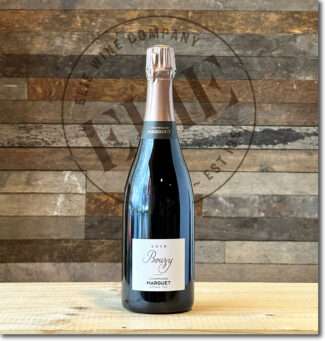 2018 Champagne Marguet Grand Cru Bouzy Rosé Brut Nature D-2/2023 ($95)
2018 Champagne Marguet Grand Cru Bouzy Rosé Brut Nature D-2/2023 ($95)
100% Pinot Noir from the chalky Bouzy terroir. Fermentation (on native yeast) and élevage is done in neutral oak and the wine is barrel-aged with long lees contact and full malolactic. The wine is juicy with ripe red berries and shows a fine bead that permeates a creamy, yet lively texture. 1275 bottles produced.
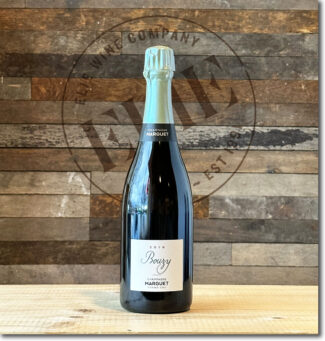 2018 Champagne Marguet Grand Cru Bouzy Brut Nature D-2/2023 ($90)
2018 Champagne Marguet Grand Cru Bouzy Brut Nature D-2/2023 ($90)
Fewer than 2175 bottles of this 100% Pinot Noir, zero-dosage Champagne from Benoît’s scant two acres in Bouzy. Having remained on lees for almost four years, the result is an opulent, powerful champagne with apple and yeast aromas and the slightly oxidative style Marguet is known for.
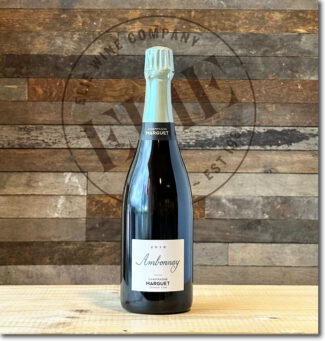 2018 Champagne Marguet Grand Cru Ambonnay Brut Nature D-3/2023 ($90)
2018 Champagne Marguet Grand Cru Ambonnay Brut Nature D-3/2023 ($90)
63% Pinot Noir and 37% Chardonnay that features a charming, biscuity nose with dried apple and lemon verbena braced by pure, shivery acidity and an underlying minerality.
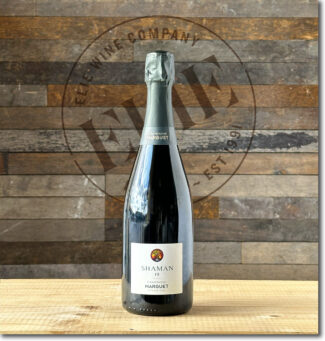 Champagne Marguet ‘Shaman 2019’, Grand Cru Brut Nature D-1/2023 ($66)
Champagne Marguet ‘Shaman 2019’, Grand Cru Brut Nature D-1/2023 ($66)
Grand Crus Ambonnay and Bouzy. 75% Pinot Noir and 25% Chardonnay. The nose shows candied ginger, dried flowers and orange blossom while the palate is creamy with marzipan, citrus and a salted nut finish.
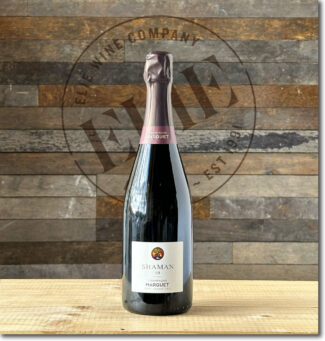 Champagne Marguet ‘Shaman 2019’, Grand Cru Rosé Brut Nature D-10/2022 ($66)
Champagne Marguet ‘Shaman 2019’, Grand Cru Rosé Brut Nature D-10/2022 ($66)
Grand Crus Ambonnay and Bouzy. 77% Chardonnay, 23% Pinot Noir vinified separately; Marguet works with a Burgundy-like system of Cru selections of single-village wine in good years, and lieux-dits in the best years. Wild strawberries and tea show on the nose, with beautifully integrated tannins and a long, yeasty finish.
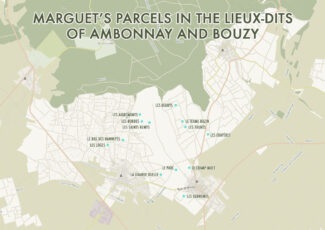
Site Specific Grand Cru Ambonnay
Whereas the ‘art’ of Champagne is often discussed in terms of expert blending—much as color is added in layers to create a portrait—a Cellar Master uses a pallet of flavors to create synergy, a whole that is greater than the sum of its parts. Traditionally, ‘house styles’ have been established over decades (even centuries) and homogeneity—in the best sense of the word—is the goal. Even vintage Champagne (assembled from a single harvest, though many villages may contribute) should highlight the house approach, since loyal customers expect as much.
So why are site-specific bottlings Champagnes growing popularity? In part because of the rising renown of grower/producers, who are highlighting individual plots of terroir that they themselves have developed. It is trendy (and completely correct) to regard Champagne as wine first and foremost, and as such, individual vineyard expression rather than cookie-cutter (however delicious) house style is simply a new way to view this old standby appellation.
Ambonnay’s vineyards are planted almost exclusively on south-facing slopes on the Montagne de Reims, mostly with Pinot Noir. Together with the vines of neighboring Aÿ and Bouzy, Ambonnay is the source of some of the most powerful Pinot Noir in Champagne; on the now-defunct ‘échelles des crus’, Ambonnay was rated 100%, making it a Grand Cru village.
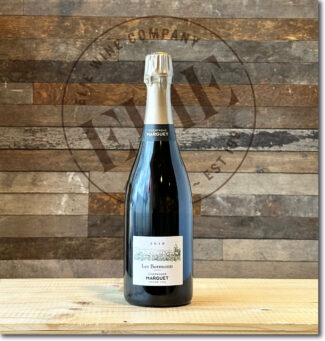 2018 Champagne Marguet Grand Cru Ambonnay ‘Les Bermonts’ Brut Nature D-3/2023 ($120)
2018 Champagne Marguet Grand Cru Ambonnay ‘Les Bermonts’ Brut Nature D-3/2023 ($120)
A Blanc de Blancs from Chardonnay vines planted in over an acre in 1952 at the base the slope, unusual for a Grand Cru village noted for its Pinot Noir. The wine features tangerine zest, salt and citrus blossoms behind acacia honey and a vibrant chalk-driven finish. 1848 bottles produced.
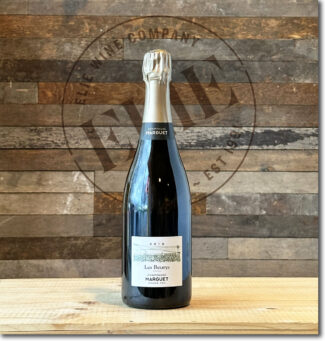 2018 Champagne Marguet Grand Cru Ambonnay ‘Les Beurys’ Brut Nature D-3/2023 ($120)
2018 Champagne Marguet Grand Cru Ambonnay ‘Les Beurys’ Brut Nature D-3/2023 ($120)
The east-facing chalky lieu-dit Les Beurys is slightly less than an acre of 35-year-old vines. The wine displays aromas of apricot, yellow plum and wild strawberry, currants with hints of spice, brioche, and white flower on the nose. Rich with great concentration on the palate, a juicy fruit core with a mineral edge, a fine and delicate mousse with great depth and a long spicy finish. 2141 bottles produced.
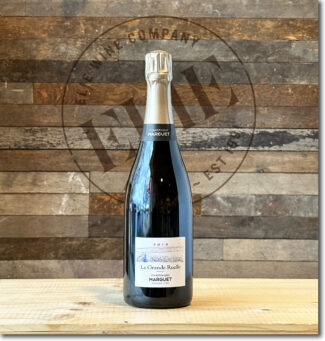 2018 Champagne Marguet Grand Cru Ambonnay ‘La Grande Ruelle’ Brut Nature D-3/2023 ($120)
2018 Champagne Marguet Grand Cru Ambonnay ‘La Grande Ruelle’ Brut Nature D-3/2023 ($120)
Marguet’s Ambonnay vineyard extends over 17 acres in the lieux-dits Les Saints Remys, Les Beurys, Les Crayères, La Grande Ruelle, Les Bermonts and Le Parc; ‘La Grande Ruelle’ 2018 is 100% Pinot Noir from a lieu-dit near Les Bermonts which Marguet believes in one of the best plots in Ambonnay. One acre planted in 1967, the vines thrive in deep clay and limestone soils. The draw took place in June 2019 and the wine was disgorged in March, 2023—only 2160 bottles were produced. The wine displays a great yeasty richness with stone fruit on the nose and a silken, elegant and precise palate.
Grand Cru Verzenay: Chalk About Champagne
It’s a fair bet that the citizens of Verzenay (oddly, called ‘bouquins and bouquines) love their windmill as much as the folks in Beaujolais’ Moulin-a-Vent love theirs. Verzenay’s sits on the Mont-Bœuf hill just west of the village and overlooks a portion of the vineland—1000 acres planted mostly to Pinot Noir. Verzenay Pinots tend to be darker in color than those of nearby Bouzy, where the slopes face south. Verzenay wines are also marked by a characteristic gaminess and an almost metallic undertone. And yet, at the same time, the north facing makes the wine somewhat lighter in weight and more tautly focused.
As usual, Verzenay’s terroir—beyond exposure—is about chalk, or more specifically, ‘super chalk’ built from the remains of microscopic, squid-like belemnites. This chalk sits near the surface in most of Champagne’s hallowed vineyard sites, including Grand Cru Verzenay, and here especially—Pinot Noir country—discredits the notion that such chalky substrate is better suited for Chardonnay.
But why? Above all else, chalk is a highly-efficient sponge, draining away excess water when it rains heavily but, crucially, storing water in times of drought. One cubic meter of pure chalk can store 660 liters of water, so vines in chalk can ride out not only heavy rains, but (increasingly) dangerous droughts which can strip the crop of its elegance and acidity.
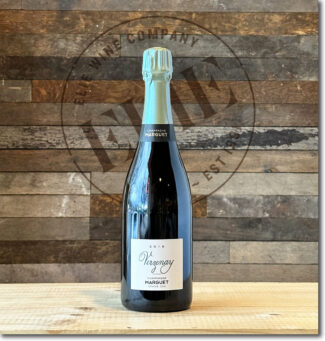 2018 Champagne Marguet Grand Cru Verzenay Brut Nature D-2/2023 ($90)
2018 Champagne Marguet Grand Cru Verzenay Brut Nature D-2/2023 ($90)
100% Pinot Noir. The nose is expressive with pretty aromas of stone fruit, pear skin, and wet stone; the palate is ripe and concentrated with Rainier cherry and Mirabelle plum. 2072 bottles produced.
The Sapience Project
Aided by a handful of like-minded individuals and completed in Marguet’s winery (with the help of Hervé Jestin), the Sapience Project utilizes the three dominant grapes of Champagne from biodynamic producers—Chardonnay from David Léclepart, Pinot Noir from Benoît Lahaye (and later from Marguet) and Pinot Meunier from Vincent Laval.
The first super-cuvée was in the 2006 vintage, and was named for the patience and experience to reach a full understanding of both the flavors and the concept.
Marguet’s spirit watches over the bottling, which occurs some 9 years from the harvest. It is a labor of love, a wine to ponder, to embrace, and to spend time with, to watch evolve, as the producers involved largely crafted this wine by virtue of decades of dedication to farming.
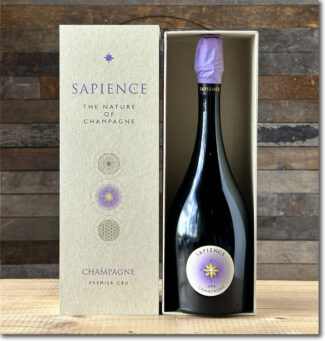 2014 Champagne Marguet ‘Sapience’ Premier Cru Brut Nature D-3/2023 ($200)
2014 Champagne Marguet ‘Sapience’ Premier Cru Brut Nature D-3/2023 ($200)
Terroirs Grand Cru Bouzy and Premier Crus Cumières and Trépail. Opinions of the 2014 vintage were mixed at the outset (plenty of rain fell throughout the summer) but at disgorgement, the wines have proven sturdy and delightful. 50% Chardonnay, 25% Pinot noir and 25% Meunier, the wine is a study in elegance brightened with freshness, showing creamy lemon curd, spring flowers, hazelnut and a trace of smokiness.
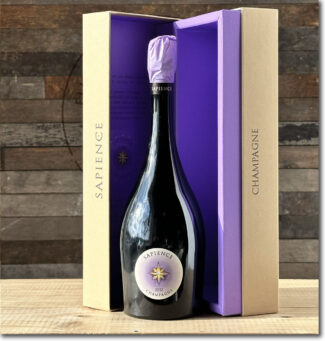 2012 Champagne Marguet ‘Sapience’ Premier Cru Brut Nature D-03-2022 ($200)
2012 Champagne Marguet ‘Sapience’ Premier Cru Brut Nature D-03-2022 ($200)
2012 was an excellent vintage for Champagne was despite the growing season throwing enough curve balls to make most producers nervous. Here, the base wine spends two years aging on forest-selection barrels before the second fermentation. With fewer than 3000 bottles made, it is rare, and has consistently been rated as highly as (or higher than) Salon and Krug.
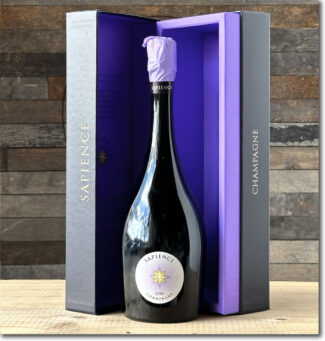 2010 Champagne Marguet ‘Sapience’ Premier Cru Brut Nature D-01-2020 ($220)
2010 Champagne Marguet ‘Sapience’ Premier Cru Brut Nature D-01-2020 ($220)
A blend of 50% Chardonnay, 25% Meunier and 25% Pinot Noir from vintages 2006, 2007, 2008, 2009, 2010, 2011 and 2012, the wine is a cooperative effort between four top biodynamic growers, Benoît Marguet, Benoît Lahaye, Vincent Laval and David Leclepart: Leclepart provided the Chardonnay, Lahaye the Pinot Noir and Laval the Meunier, while the vinification was done in Marguet’s cellar. The base wine spends two years aging in barrels before the second fermentation in bottle. With the balance and effortlessness of the best grand marques and the depth of terroir of the best grower Champagnes, the wine provides a creamy nose with hints of dried fruit; warm nut-bread flavors on the palate that are in absolute harmony with the wine’s vibrant minerality.
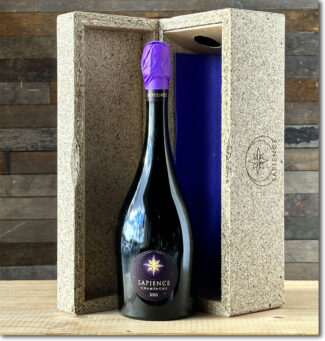 2010 Champagne Marguet ‘Sapience Oenothèque’ Premier Cru Brut Nature D-3/2023 ($280)
2010 Champagne Marguet ‘Sapience Oenothèque’ Premier Cru Brut Nature D-3/2023 ($280)
Produced only in 2007, 2008, 2009 and 2010, this meticulously crafted wine is a blend of 50% Chardonnay, 25% Meunier and 25% Pinot Noir from prized terroirs in Trépail, Cumières and Bouzy. Disgorged in March 2023 and bottled without dosage, the 2010 Brut Nature Premier Cru offers aromas of fresh pastry, golden apples, white flowers and walnuts followed by a full-bodied, layered and concentrated palate that’s vinous and intense with elegant structure and a sapid finish.
Coteaux Champenois: A Nod To Burgundy
The tale of Champagne’s proximity to Burgundy is told in varieties; Pinot Noir and Chardonnay make up 81% of Coteaux Champenois’ plantings. Also allowed is the other Champagne staple Pinot Meunier along with less cited Arbane, Petit Meslier and the Pinot derivatives, Pinot Blanc and Pinot Gris.
Like their fizzy sisters, still wines from the region tend to be dry and light-bodied with naturally high acidity. The reds are better in warmer vintages, which is why the predominant red variety, Pinot Noir, is currently basking in the newfound heat waves of northern France. The reason that 90% of the Coteaux Champenois output is red is not necessarily because the terroir has traditionally favored Pinot Noir, but because locally grown Chardonnay has commanded a higher price when sold to Champagne houses.
But a new generation of grower/producer is taking advantage of the more consistent ripening of red grapes, including Pinot Meunier, to explore terroir and individual lieux-dits in a manner more familiar in Burgundy than Champagne. Says Simon Normand of Domaine La Borderie: “Here in the Côte des Bar we feel quite close to our Burgundian cousins. Many local young winegrowers, such as myself, studied in Burgundy rather than in Champagne.”
Also from the Coteaux Champenois is a unique still rosé called Rosé des Riceys, once a favorite of the Sun King, Louis XIV. Made in tiny quantities by only a small handful of producers, Rosé des Riceys is made through the semi-carbonic maceration of Pinot Noir grapes and can have exceptional aging potential for still rosé.
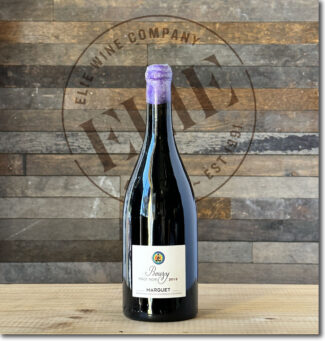 Domaine Marguet, 2018 Coteaux Champenois ‘Grand Cru Bouzy’ Red ($110)
Domaine Marguet, 2018 Coteaux Champenois ‘Grand Cru Bouzy’ Red ($110)
Produced only in 2007, 2008, 2009 and 2010, this meticulously crafted wine is a blend of 50% Chardonnay, 25% Meunier and 25% Pinot Noir from prized terroirs in Trépail, Cumières and Bouzy. Disgorged in September 2020 and bottled without dosage, the 2010 Brut Nature Premier Cru offers aromas of fresh pastry, golden apples, white flowers and walnuts followed by a full-bodied, layered and concentrated palate that’s vinous and intense with elegant structure and a sapid finish.
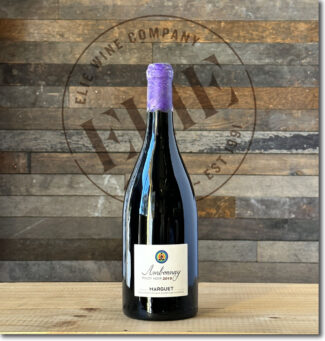 Domaine Marguet, 2018 Coteaux Champenois ‘Grand Cru Ambonnay’ Red ($110)
Domaine Marguet, 2018 Coteaux Champenois ‘Grand Cru Ambonnay’ Red ($110)
Pinot Noir requires more hang-time on the vine to fully ripen, and Marguet only produces red Coteaux Champenois in exceptionally warm years; 2018 was one of them. Les Saint Rémys is a parcel of 100% Pinot Noir located on the west side of Ambonnay near the border of Bouzy and produces a lightly-toned red wine with plum, raspberry and sloe on the nose followed by a silky, fruit-driven palate with the tug of stony minerality.
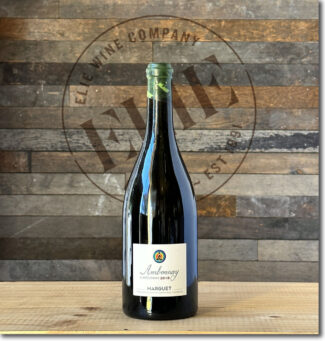 Domaine Marguet, 2018 Coteaux Champenois ‘Grand Cru Ambonnay’ White ($110)
Domaine Marguet, 2018 Coteaux Champenois ‘Grand Cru Ambonnay’ White ($110)
100% biodynamically-farmed Chardonnay from lieux-dits Les Saints Rémys and Le Parc; the nose is floral with aromas of apple white peach blossom, while the palate is concentrated with bees-wax and orange oil flavors with an intense chalkiness at its core. The Grand Cru finish is long and layered.
Notebook ….
Drawing The Boundaries of The Champagne Region
Having been defined and delimited by laws passed in 1927, the geography of Champagne is easily explained in a paragraph, but it takes a lifetime to understand it.
Ninety-three miles east of Paris, Champagne’s production zone spreads across 319 villages and encompasses roughly 85,000 acres. 17 of those villages have a legal entitlement to Grand Cru ranking, while 42 may label their bottles ‘Premier Cru.’ Four main growing areas (Montagne de Reims, Vallée de la Marne, the Côte des Blancs and the Côte des Bar) encompass nearly 280,000 individual plots of vines, each measuring a little over one thousand square feet.
The lauded wine writer Peter Liem expands the number of sub-regions from four to seven, dividing the Vallée de la Marne into the Grand Vallée and the Vallée de la Marne; adding the Coteaux Sud d’Épernay and combining the disparate zones between the heart of Champagne and Côte de Bar into a single sub-zone.
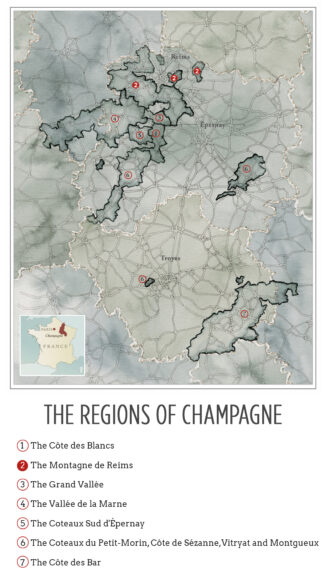
Lying beyond even Liem’s overview is a permutation of particulars; there are nearly as many micro-terroirs in Champagne as there are vineyard plots. Climate, subsoil and elevation are immutable; the talent, philosophies and techniques of the growers and producers are not. Ideally, every plot is worked according to its individual profile to establish a stamp of origin, creating unique wines that compliment or contrast when final cuvées are created.
Champagne is predominantly made up of relatively flat countryside where cereal grain is the agricultural mainstay. Gently undulating hills are higher and more pronounced in the north, near the Ardennes, and in the south, an area known as the Plateau de Langres, and the most renowned vineyards lie on the chalky hills to the southwest of Reims and around the town of Épernay. Moderately steep terrain creates ideal vineyard sites by combining the superb drainage characteristic of chalky soils with excellent sun exposure, especially on south and east facing slopes.

Single Harvest vs. Vintage
In France, under Appellation d’Origine Contrôlée (AOC) rules, vintage Champagnes must be aged for three years—more than twice the required aging time for NV Champagne. The additional years on the yeast is said to add complexity and texture to the finished wine, and the price commanded by Vintage Champagne may in part be accounted for by the cellar space the wine takes up while aging.
On the other hand, a Champagne maker might prefer to release wine from a single vintage without the aging requirement; the freshness inherent in non-vintage Champagnes is one of its effervescent highlights. In this case, the wine label may announce the year, but the Champagne itself is referred to as ‘Single Harvest’ rather than ‘Vintage’.
A Gift That Keeps On Giving
Membership To ‘The Champagne Society’
Bimonthly Subscription
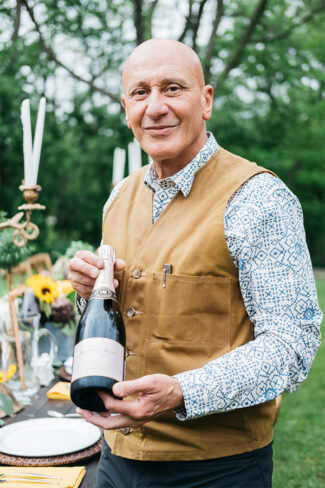 Not only is Champagne the quintessential drink of celebration, it has traditionally been a gift given with ramped-up sentiments. This year we are offering a couple of variations on this theme, beginning with an opportunity to gift a special someone a six-month or twelve-month membership to The Champagne Society. Our pick for December will be packaged in a wrap-ready gift box along with a congratulatory certificate explaining what lies ahead in bi-monthly installments. For more information please visit our website page: A Holiday Gift: ‘The Champagne Society’ Membership 6-Month ($299) or 12-Month ($589) Subscription.
Not only is Champagne the quintessential drink of celebration, it has traditionally been a gift given with ramped-up sentiments. This year we are offering a couple of variations on this theme, beginning with an opportunity to gift a special someone a six-month or twelve-month membership to The Champagne Society. Our pick for December will be packaged in a wrap-ready gift box along with a congratulatory certificate explaining what lies ahead in bi-monthly installments. For more information please visit our website page: A Holiday Gift: ‘The Champagne Society’ Membership 6-Month ($299) or 12-Month ($589) Subscription.
Elie
- - -
Posted on 2023.12.24 in France, Champagne, Wine-Aid Packages | Read more...
Back To The Roots Of Wine: A List Of Trios Showcase The Diversity Of France’s Wine Regions A Fresh Look Into What Makes The Country The Wine World’s North Star
The world is a galaxy of wine, and at its center lies a vinous, red-and-white hole of such density that all other wine regions tend to circle it, drawn by the gravity of its reputation and know-how. These other regions are not necessarily ‘pretenders’ and indeed, some of the students have at times transcended the master. They are satellites drawing energy from a mothership called France: Cabernet Sauvignon and Sauvignon Blanc, Pinot Noir and Chardonnay, all are benchmark varieties in nearly every pocket of the planet that can support them.
Through ups and downs, missteps and natural disasters, the immensity of this tug remains, and at Elie’s, it remains irresistible, even if it may be time to paint over the Mona Lisa.
France has always been its own best friend and worst enemy; a truism in times of war and peace. An epicenter for cuisine and fine wine, it has tended to rest on its laurels a bit too long, until reputation became a stand-in for quality. And then, waking up, in a desperate attempt at reinvention, it has occasionally strayed down rocky roads. Still, the French begin with an advantage denied nearly everyone else—spectacular terroir across the whole of its wine producing regions. Rebounding from the blunders of the late twentieth century, when Robert Parker Jr.’s vaunted love of amplitude over austerity, plushness over earthiness, accessibility over ageability, caused some French vignerons to trade their gracefully-composed French styles for the warm-weather lavishness of Napa’s style, and the changing climate cooperated by stringing together hotter, drier vintages more than capable of producing this sort of wine.
But despite the focus of the mainstream press, the soul of French wine has always been found in the beautiful countryside, and as a younger generation of winemakers comes of age, and embraces new/old concepts like biodynamics and revitalized vineyard soil, there is New French wine movement taking hold. The depredations of industrial farming is beginning to be seen in a rear-view mirror and once again, the concept of ‘terroir’ is not viewed as a marketing tool; it is seen as an indispensable passport to identity.
As die-hard fans and unabashed Francophiles, Elie’s is pleased to be at the forefront of discovery, especially when new faces appear at old venues. Some are scions, others pioneers, but the fact remains that now, and for the foreseeable future, French wines not only matter, but when they live up to their best ideals, remain the lodestar for the global wine industry.
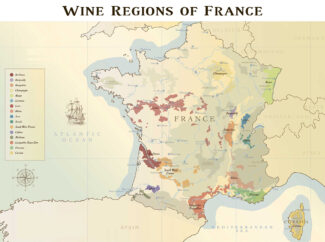
The New Frence: Neoclassicism and ‘New Wave’ Wines. (The Myth of An Immutable France.)
Terroir may be written in stone (and soil and climate) but culture is not. Although wine represents the most valuable sector of French agriculture, the attitude of the people toward it has changed rather dramatically over the past few decades. Wine consumption in France is half what it was in the 1960s; younger generation that has turned away from wine more than any other age group. In February 2023, Agriculture Minister Marc Fesneau announced plans to help the industry respond to what he described as a ‘crisis in the wine sector’, including financial aid for producers wishing to distill excess wine and supporting growers by developing longer-term plans in light of climate change challenges and evolving consumption patterns.
In the meantime, the ever-resilient old guard, refreshed with novel ideas as a new generation takes the reins, has laid the ground work for what author Jon Bonné refers to as ‘neoclassicism’—a return to the roots, where wines taste more transparently of its origin, and regions not previously regarded for quality have discovered that a host of new techniques—bolstered by warmer, drier weather—has transformed outlying appellations from blips on the radar to regions that demand our attention. And in a land where time-honored tradition is sacred, this shift in thinking is nothing short of seismic.
At Elie’s we have followed these trends with our own personal microscope, wandering the hectares, talking to the vignerons, sampling from cellars full of this new-wave of French wines. As France is not immutable, neither are we, and armed with both a love for French wine and a fascination with its expansive evolution, we will do our best to be the most comprehensive source of neoclassical French wines on this side of the Atlantic.
Climate Change Pushes Vignerons To Rethink Winemaking Practices
Freak frosts and soaring temperatures, devastating droughts and downpours, sultry winters that encourage vines to bloom before their time—these are mere symptoms of the larger condition (which may, in many cases, be called a catastrophe) known as global warming. In France, where many vineyards exist in a precarious ‘Goldilocks zone’ of grape viability, this phenomenon has forced changes in such practices as have seen winemakers through centuries.
Short of lighting up hundreds of flaming candles and using the downdraft from helicopters to protect precious young buds (as occurred across France in 2019), winemakers are clenching their hidebound teeth and replanting vineyards to previously ungrowable varieties. The Jura, for example, is producing higher-quality Pinot Noir than ever before and vintners are delving back in time to the historic varieties of the area that were abandoned decades ago. Producers are rethinking canopy management, vine trellising and pruning techniques, developing cover crops and extensive shading methods, increasing vineyard biodiversity and finding ways to reuse water during droughts.
Climate change is complicated, and even if temperature is the most influential factor in overall growth and productivity of wine grapes, there’s far more to consider: Rainfall is pivotal, and too much rain during harvest season can lead to watery grapes and a weak vintage, while humid conditions in the spring lays a welcome mat for pests, fungi and mildew. Rising sea levels play a role as well, and it is likely to get worse: According to NASA, oceans worldwide are estimated to surge at least 26 inches by 2100, and will decimate coastlines and their sway over nearby viticultural regions.
Alsace
According to many of us, the wines of Alsace are criminally under-represented on most wine lists and in most collections, but in this cool corner of northeast France is surfacing those eager to carry forward the torch. To each of them, a critical question arises: “Do I continue to make wines in the style my fathers and grandfather, or implement changes to show a different approach?”
Jean-Frédéric Hugel from Hugel in Riquewihr responds this way: “If you need proof of climate change, ask vintners; grapes and are great witnesses of it. At the beginning of his career my grandfather saw a regular harvest start on October 15th, so that’s when he brought in bring pickers to start a six-week harvest. Today we harvest in 4 to 5 weeks and start on average 15th of September and in 2018 and 2017, the 7th and 5th of September, with sugar content far higher than in later harvests of the past.”
Overall in Alsace, climate change has been a blessing, as in the past, the main challenge was ripening grapes. On average, the region once saw two unripe vintages per decade and produced wines that would have been unsellable in the current market. Now, they are rare, while the two ‘exceptional’ vintages per decade that Alsace once enjoyed has become four, and often, six.
$89 White Alsace Trio: Riesling, Gewürztraminer, Pinot Blanc
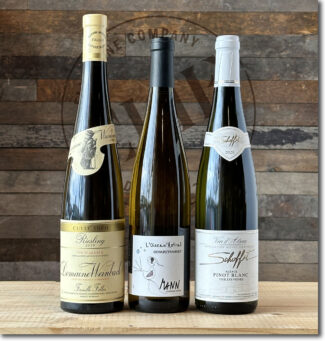
Alsace Riesling, Domaine Weinbach ‘Cuvée Théo’ 2019 white ($39)
An elegant, pure and aromatic Riesling from the Weinbach clos, made with biodynamic grapes; it offers ripe citrus on the nose, yellow peach on the palate and a salty-piquant finish with plenty of athletic acidity.
Alsace Gewürztraminer, Domaine Mann ‘L’Oiseau Astral’ 2020 white ($30)
‘The Astral Bird’ is an expressive Gewürz from Biodyvin-certified vineyards; it shows nice extracted fruit, with lychee and mangosteen in the forefront and spicy acidity that gives it remarkable length.
Alsace Pinot Blanc, Domaine Schoffit ‘Vieilles Vignes’ 2020 white ($20)
A blend of Pinot Blanc and Pinot Auxerrois, from a plot where the average vine age is fifty years. Expressive up front with musky floral tones and a succulent apple core, a wisp of sweetness, zesty acids and plenty of grip on the finish.
Burgundy
As writer Jon Bonné maintains, “It’s not that the world hasn’t always revered Burgundy, but the past two decades have been very good to this sliver of eastern France. The Côte d’Or has become the darling of wine lovers as no other place has—its popularity today is unprecedented and its best vineyards and producers are the stuff of modern legend. Fans pore over esoteric maps and data in a way that verges on fetish, and they pay dearly to celebrate with their fellow Burgundy lovers.”
Even so, at the turn of the twenty-first century, Burgundy was just beginning to recover from disastrous winemaking decisions that marked the late 1980s and early 1990s, when red Burgundies were often deeply extracted and thick and aged in too much new oak with the goal of emulating the bigger style of Pinot Noir gaining favor at the time. The whites, in contrast, had a tendency to oxidize prematurely.
These days, the requisite changes in thinking are being wrought by pioneering, educated and confident winemakers, many of whom are very young. Organics and biodynamics are understood as being the only logical choice to restore terroir (rather than marketing) as the essence of the Burgundian persona.
$142 Red & White Burgundy Trio: Givry, Mercurey, Rully
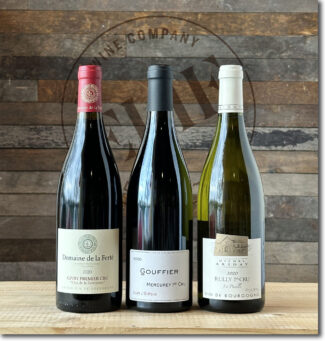
Givry, Domaine de la Ferté Premier Cru Clos de la Servoisine 2020 red ($44)
The Clos represents just under two acres of vines planted in the early 1970s in dense clay and silty soils. Natural yeast fermentation followed by aging in large foudres; the wine shows lush blackberry with an edge of dark chocolate and spice, supple tannins and a balanced finish.
Mercurey, Gouffier Premier Cru Clos l’Évêque 2020 red ($49)
Hand-harvested organically-grown grapes vinified 40% whole cluster and aged in 228 liter barrels for a year. It offers silken cherry notes, earthy forest floor, bramble berries and a lean, chalky finish.
Rully, Domaine Michel Briday Premier Cru La Pucelle 2020 white ($49)
From an acre and a quarter planted on shallow clay; this Chardonnay comes from 45-year-old vines and shows richly concentrated citrus notes, green apple, white flowers and a touch of toast and flint on the finish.
Beaujolais
‘Beaujolais Nouveau’ may stir up some unpleasant memories, but New Beaujolais—coming of age during the global climate crisis—is different sort of critter. The pitfalls are legion: “It’s easier to find a drought-resistant grape variety than it is to convince both producers and wine-loving public to drink it,” says Natasha Hughes, MW. For Beaujolais, a one-trick pony named Gamay, the experimental mix of Alsace and Rhône varieties may be a hard sell, but it forms a component of research by Sicarex—an organization working on behalf of Beaujolais to mitigate the worst excesses of climate change.
Even so, that is not how the story of modern Beaujolais will likely resolve itself. Gamay will not only survive intact, it may well become a younger generation’s substitute for the red Burgundy they cannot afford and are likewise unwilling to invest the time required for it to reach full maturity. Wines built for upfront drinkability, made without status markers like new oak, are becoming not only acceptable, but embraced as great wines. Beginning in the 1980s, a group of Beaujolais winemakers began to reconsider farming practices and cellar work, believing that ripe fruit and diligent, controlled winemaking with native yeasts could make far better Beaujolais. Their legacy is obvious today, and Beaujolais—the Crus especially, but not exclusively—are a totem of how wine itself has changed.
$125 Red Beaujolais Trio: Morgon, Fleurie, Moulin-à-Vent
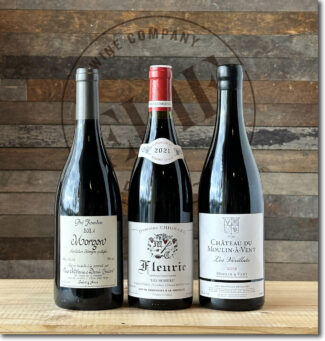
Morgon, Mélanie et Daniel Bouland ‘Pré Jourdan’ 2021 red ($39)
Ample and fleshy, the wine displays a rich nose of raspberries, cherries and sweet spices, with espresso, wood smoke and ripe tannins in the mid-palate.
Fleurie, Domaine Chignard ‘Les Morier’ 2021 red ($29)
‘Les Morier’ is an exceptional vineyard, steep and stony with a granite core, and a portion of it reaches into Moulin-à-Vent—an appellation known for its structural depth and Rhône-like aromatics. True to form, the wine is velvety and fleshy, showing mulberry and cherry preserves over a focused, elegant nucleus.
Moulin-à-Vent, Château du Moulin-à-Vent ‘’Les Vérillats’ 2019 red ($57)
At 1000 feet, Les Vérillats perches atop the hill, even above the famous windmill, where a thin layer of sand covers pink granite. 45-year-old vines give the wine enviable depth and structure to support notes of mature red and black fruit, hints of spice and a persistent floral river of rose, peony and violet.
The Loire
The Loire, from Muscadet to Sancerre, is another French wine region that is changing so rapidly that it is difficult to keep up. The natural wine movement finds its unofficial headquarters here, and if the gorgeous châteaux and picturesque chalky-limestone villages speak to the past, the winemakers have their sights set on the future. Whereas the Loire’s white wines have long held a reputation for their remarkable depth, particularly among white Burgundy lovers seeking an affordable substitute, and the reds, generally made from Cabernet Franc, have legions of Bordeaux fans, they are increasingly seen as something more than an alternative wine. They have established a modern reputation of being soulfully complex and savory, remarkably expressive of their individual terroirs.
“In the 1980s, the wines were known for being easy and simple,” says Matthieu Vallée of Château Yvonne, one of Loire’s up-and-coming talents. “Now it’s finally changed, and people can see a different side.”
$97 White Loire Trio: Muscadet Sèvre-et-Maine, Sancerre, Montlouis-sur-Loire
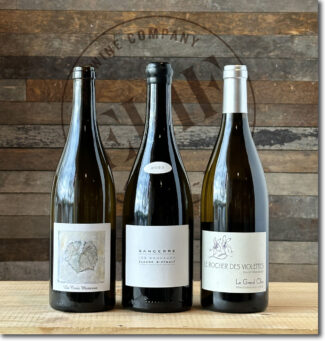
Muscadet Sèvre-et-Maine, Complemen’ Terre ‘La Croix Moriceau’ 2021 Natural white ($29)
The Melon de Bourgogne grapes are manually harvested and stainless steel tanks are used for débourbage before racking into smaller concrete vats for fermentation and elevage for 7-8 months. The wine then undergoes malolactic fermentation, and minimal sulfur is added at bottling. The wine is racy and tight, with macerated apple notes and a slight, pleasant oxidation and on the finish to accompany crushed stone, salinity and a whiff of campfire.
Sancerre, Domaine Claude Riffault ‘Les Boucauds’ 2022 white ($36)
The Sauvignon Blanc grapes are grown in the deep clay of Les Boucauds lieu-dit, which lends fullness to the fruit and produces a tropical profile with melon, pear and pineapple alongside white flowers.
Montlouis-sur-Loire Sec, Le Rocher des Violettes “Le Grand Clos” 2020 white ($32)
The Chenin Blanc grapes originate in three lieux-dits in Mont-Louis, Les Borderies, Le Grand Clos and Bel Air. These are the oldest vines of the estate (90+ years old) and are subjected to high density plantings on south facing slopes where the terroir is clay and silex above pure chalk. The wine shivers with crystalline acidity and shows flecks of richness amid white flowers, ripe lemons and subtle honeyed notes.
Bordeaux
Dollar for dollar, Bordeaux produces more wine than anywhere else in France; its marketing power, reputation and history have impelled it to a pinnacle in the imagination of most of us. Still, the perch is precarious, in part because it has largely been built around the 1855 classification system that ranks its top properties. And nearly everyone not atop that pyramid views it as past its expiration date.
Of Bordeaux’s 8,500 properties, only about 120 benefit from this hierarchy, and if ever a wine region was screaming for an updated perspective, it’s Bordeaux.
Even the hidebound Conseil Interprofessionnel du Vin de Bordeaux (the Bordeaux Wine Council, formed in 1948) seems on board. Six new grapes join Bordeaux’s previously approved varieties in an effort to adapt to climate change, and the area home to a growing number of producers making eminently drinkable wine at artisan scale, while avoiding the style wars that have fueled the region’s woes.
As can be seen elsewhere in France, biodynamics and biodiversity, and often, lighter extractions closer to the classic ‘claret’ style, is a stand against the hive mind in Bordeaux. This is being driven by vignerons rather than public relations firms, people who believe in human-scale Bordeaux and who farm with an eye toward organics and who revere the freshness and integrity that has made the region so beloved.
$124 Red Bordeaux Trio: Saint-Estèphe, Saint-Émilion, Pessac-Léognan
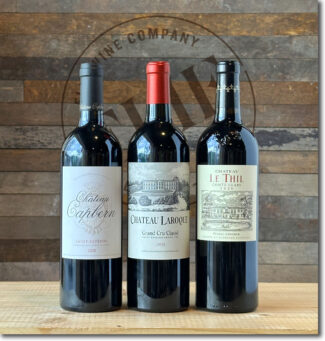
Saint-Estèphe, Château Capbern 2020 red ($38)
A Cabernet Sauvignon-dominated blend that includes 37% Merlot and 1% Petit Verdot, all of which was brought up in 60% new barrels, resulting in a deep, dark, earthy, classic Saint-Estèphe with cassis and blueberry as well as ample chocolate, damp earth and leafy herb-like aromas and flavors.
Saint-Émilion, Château Laroque Grand Cru Classé 2018 red ($44)
97% Merlot and 3% Cabernet Franc from one of the highest sites in the appellation. The wine shows flamboyant notes of stewed plums, Black Forest cake and boysenberries plus hints of candied violets, star anise and tobacco leaf with a waft of sassafras.
Pessac-Léognan, Château le Thil Comte Clary 2020 red ($42)
Blackberries, currants and hints of hazelnut form the framework of a sensuous and lithe wine with multiple spice nuances—cloves, ginger and soft mint.
The South-West
Nowhere in France is the notion that ancient grapes do best in their native soils more pronounced than in the southwest; critics and rule makers be damned. Some of these grapes grew wild, while others found places where they thrived after Roman soldiers and medieval troubadours carried them through hills and valleys. Though the cast is enormous, many of these vines are not found elsewhere and are varieties with which many of us are only peripherally familiar: grainy Négrette, small-berried Petit Manseng, local Tannat whose name, it is assumed, derives from its mouth-puckering tannin content. Some are grapes that have all but disappeared, but are now being revived by growers who revel in the homegrown DNA and are modernizing tradition rather than breaking with it.
Having at one time receded into the role of humble country wine, a new generation of vignerons in the southwest are beginning to produce remarkable, avant-garde wines. Natural-minded, new-wave winemakers are appearing on the scene with increasing regularity. They seem to have a deep appreciation for the nuance and depth of southern traditions, maintaining its bounty of local grapes and eager to connect best of the countryside’s past to the future. They are quiet heroes and quality-focused pioneers demanding change from the twentieth-century norm and the Southwest’s blandly commercial path.
$101 Red & White South-West Trio: Cahors, Côtes-de-Bergerac, Bergerac
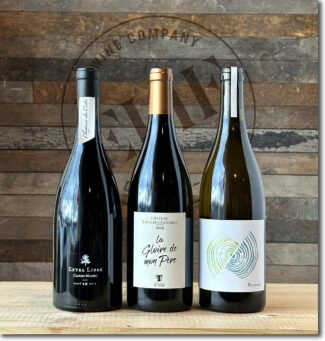
Cahors, Château du Cèdre “Extra Libre” Natural 2019 red ($31)
The winery eliminated the use of chemicals in 1992, emphasizing sustainable practices and minimal intervention in the vineyards—this blend is 90% Malbec, 5% Merlot and 5% Tannat, hand-harvested from vines between 15 and 30 years of age, fermented in concrete tanks, then aged 12 months in large, used barrels. The wine shows vibrant acidity, to brace its dark fruit, cocoa and very fine tannins.
Côtes-de-Bergerac, Château Tours des Gendres ‘La Gloire de Mon Père’ 2018 red ($31)
A blend of 53% Merlot, 35% Cabernet Sauvignon and 12% Cabernet Franc that spends 12 months in oak and six months in bottle before release. A smooth and creamy palate juicy with concentrated blackberry and cherry notes, a hint of smoke and a long, mineral-driven finish.
VdF Bergerac, Combrillac ‘Petchalba’ 2021 white ($39)
An interesting and unusual blend: 50% Sauvignon Blanc, 40% Sémillon and 10% direct-pressed Cabernet Sauvignon. Named for a Macedonian rite of passage, the wine is aged in a mix of Italian sandstone amphorae and used barrels and bottled without fining or filtering.
Jura
‘Voile’ is a term that most wine people associate with the Jura’s late-harvested Vin Jaune—a thin veil of yeast that floats atop the vat to toughen and mature the must, exposing it to limited amounts of oxygen. But in the Jura, it is used not only in their famed, sherry-like ‘yellow wine’, but in many others based on the local Savagnin variety.
It’s an interesting method, not to everyone’s tastes, and perhaps a problem as modern wine drinkers look more and more to terroir and less to technique. But the switch is not far-fetched in Jura, whose soil is somewhat similar to its grand neighbor to the west, Burgundy (both sit on an ancient seabed) and limestone and clay in varying configurations that can accommodate Chardonnay as well as Savagnin. Ironically, in Jura, the radical reinvention is to go more mainstream—Jura’s conventional winemaking is unconventional in the rest of France, and a growing number of winemakers believe that it blurs the region’s true potential.
“With the traditional style, all the wine was looking similar after oxidation with the veil,” says Julien Labet, one of the champions of the new style, called ‘ouillé.’ “They all had that nutty taste, and didn’t have the personality they had before the veil.”
Resistance has been marked, largely because the Jura enjoys its reputation as an outsider and frowns on any changes designed to erase its uniqueness. Still, there is little chance that the appellation will ever become ‘like everybody else.’ Chardonnay planted to densely spaced, head-trained on the Jura’s terroir yields wine that are more savory and saline than their Burgundian cousins, their fruit and flavors a bit more generous.
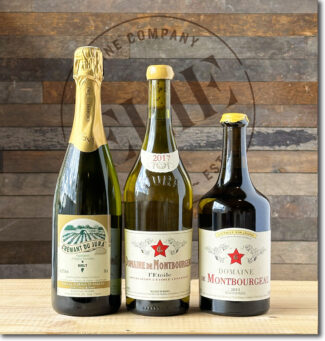
Crémant-du-Jura Brut, Domaine Overnoy-Crinquand ($33)
100% Chardonnay with 30 months of lees contact and a mere 0.5 grams per liter dosage. A non-vintage wine but produced exclusively from a single vintage, it offers textural plushness and breadth balanced by iron-tinged minerality and a gently honeyed character.
L’Étoile, Domaine de Montbourgeau 2017 white ($30)
95% Chardonnay with Savagnin topping off the blend, this wine originates on the southeastern slopes of L’Étoile, where vines average 40 years. Following malolactic fermentation, it spends up to three years in neutral oak, giving it what may be considered a ‘typical’ Jura profile for Chardonnay, tasting slightly oxidized, although not nearly in the style referred to locally as ‘sous voile’, or ‘under veil’—referring to the yeasty flor that characterizes Vin Jaune. About 20,000 bottles are produced: It is the winery’s mainstay.
L’Étoile, Domaine de Montbourgeau 2011 ‘Vin Jaune’ ($89)
Befitting the style, this Vin Jaune is 100% Savagnin grown on blue marl rich in limestone. The wine spends one year in small, neutral oak casks followed by six years in larger hogsheads, allowing for the longer, requisite maturation period. The wine displays quince jam notes sheathed in warm, yeasty lemon curd and resonant acidity. Around 3000 bottles made.
Savoie
Metaphors linking wine to its place of origin are the stuff of poetry, but they’re also the foundation of terroir. Among the most common descriptors of the area’s high-altitude wine is ‘refreshing’ which is an offhand way of saying that it tends to be lower in alcohol and higher in acidity than valley wines. These acids are often the end result of the cool mountain air which they resemble, giving distinct, cleansing mineral characteristics to the wine with citrus and herbs rather than jammy fruit. Alpine wines have a crunchy sizzle and a cool sappiness unlike wine from anywhere else. Not only that, but the predominant grapes don’t show up on many other radars, so the unique textures commingle with a whole new flavor profile to surprise and delight the palate.
Over the past twenty years, a new wave of independent vignerons has been boosted by organizations dedicated to preserving these singular grape varieties, and Savoie has finally begun to come into its own. Natural wine is increasingly becoming the order of the day—elevations are such that the mildew that affects vines at sea level is not an issue, and like wines from the Jura were a decade ago, Savoie wines are still considered somewhat geeky and under-the-radar—which makes it an ideal region for innovative winemakers from a younger generation to make their mark.
$114 Red & White Savoie Trio: Savoie, Savoie-Arbin, Roussette-de-Savoie
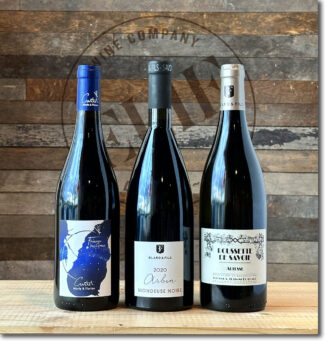
Vin de Savoie, Domaine Marie & Florian Curtet ‘Frisson des Cimes’ Natural 2019 red ($45)
An interesting blend of organically-farmed Mondeuse, Gamay and Pinot Noir planted in sandstone with a southwestern exposure. It is made with whole cluster fermentation and without pump overs, which lasts around a month before pressing. This is a dark, pungently earthy wine with notes of mulched forest floor, black plum, blueberries, pine, Kalamata olives and roasted meat.
Vin de Savoie Arbin, Blard & Fils ‘Mondeuse Noire’ 2020 red ($39)
Mondeuse is a local variety often described as a cross between Pinot Noir and Gamay with a touch more tannin. This offering is grown in clay and limestone soils and there is a pronounced iron-rich mineral note on the nose along with red fruit and lacy mouthfeel.
Roussette de Savoie, Blard & Fils ‘Altesse’ 2020 white ($30)
Made from 100% Altesse grown on Mont Granier scree—a mix of clay and limestone with a bit of marl and silex. 80% of the grapes are direct-pressed while 20% are destemmed and macerated on the skins for 10 days. The wine is wild yeast fermented and aged on the skins in stainless steel tanks for 10 months and bottled without filtering or fining. A nice backbone of acidity sets off notes of bergamot, honey and hazelnut, mountain herbs. As an aside, the traditional pairing for Roussette de Savoie is Raclette and its typical sides of boiled small potatoes, charcuterie, and apricot mustard.
The Rhône: North
Fifty years ago, both Côte-Rôtie and Cornas along with much of the northern Rhône, were struggling just to survive. Around 1966, when the appellation had fallen into obscurity, its overseers simultaneously decided to revive quality, but also to expand to the flatlands above its rocky granite and schist terraces. The appellation’s traditional method of farming steeply-sloping vines by hand made for pretty images, but were a curse financially. The expansion ended a traditional style of Côte-Rôtie that had been fresher, even a bit light, and more overtly spicy than fruity.
By the 1990s, the most popular wines of Northern Rhône were thick and heady, made with carefully controlled fermentations, heavy extractions and plenty of new oak. As the climate warms, the conditions that produce big, high-alcohol wines are becoming the rule of the day. Not only that, but rising temperatures parallel the rising cost of vineyard acres, and many properties are being snapped up by wealthy overseas investors who care more for market appeal than subtle winemaking.
But a number of smaller, previously dormant areas that nestle in pockets near the big-name appellations in the Rhône have begun a remarkable comeback; this is the result of hard work by few steadfast vignerons who have saved noteworthy properties from being reclaimed by forest. It is among these parcels of land, which peek through mostly unfriendly hinterland that we make our modern-day discoveries— worthy and exciting Syrahs; the best made since the phylloxera blight wiped out the original vineyards in the 1800s.
$124 Red Northern Rhône Trio: Côte-Rôtie, Crozes-Hermitage, Saint-Joseph
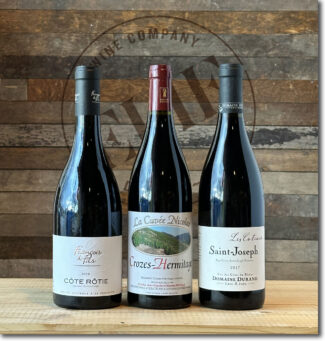
Côte-Rôtie, François & Fils 2019 red ($67)
Classic Côte-Rôtie notes of violets and crushed blueberries bathed in silky ripe tannins. A traditional co-ferment with 4% Viognier that offers a floral lift and a touch of nutmeg in the finish.
Crozes-Hermitage, Domaine Jean-Claude et Nicolas Fayolle ‘La Cuvée Nicolas’ 2020 red ($25)
100% Syrah from youngish vines grown in Gervans, a small granitic outpost within CrozesHermitage. Full-bodied without being heavy, ripe without being jammy, the wine is juicy with brambly wild berries, licorice and creamy mocha tones.
Saint-Joseph, Domaine Éric et Joël Durand ‘Les Coteaux’ 2017 red ($32)
Big-shouldered, yet velvety, concentrated and rich, the wine shows cherry and plum pudding infused with anise and accented by warm fruitcake spices.
The Rhône: South
2021 is an example of the sort of challenging vintage the producers in Southern Rhône are facing; a wet winter was followed by an unseasonably hot spring, followed by an extensive frost in April that drastically reduced yields. In November these climatic extremes reduced overall French wine production by 27 % and the vintage proved to be one of French wine’s most difficult years on record.
But the effects of climate change are hardly restricted to a single season. In recent years, each individual vintage has presented its own unique set of trials, an inevitable offshoot of rising temperatures, which on average have increased 1.5°C; predictions are that things will get worse. Of course, it’s not limited to France, but the delicacy of the vineyard ecosystem is Southern France is being battered by heat waves, drought and fires, there are also spring frosts, hail, and excessive rain with damage wrought by one or more in any given year.
As the world is eager for Rhône wine and winemakers understand they must be willing to provide enough of it, they look for a silver lining, even if it means rethinking France’s longtime wine regulations. As relatively new appellations like the villages of Gigondas and Vacqueyras gaining fame, attention has turned to other, as-yet-unexploited areas where climate change may be a blessing in disguise. Historically, elevation has not been a defining characteristic of the region, as the vast expanses of the Côtes du Rhône to Cru appellations like Châteauneuf-du-Pape, Gigondas and Vacqueyras, the vineland is characterized by rocky flatlands where ample sunlight pumps richness into the wines.
According to Christian Voeux, owner and winemaker of Domaine de l’Amauve, located just north of Gigondas, “In the past, altitude was not considered an advantage for winegrowers in Southern Rhône. High altitudes would delay the maturity of grapes, and when full maturity was finally reached at the end of September or October, heavy rains would come, affecting the quality of grapes.”
Over the last two decades, climate change has rewritten the rule book. Throughout the Southern Rhône, a steady annual increase in temperature has expanded the possibilities for viticulture into a diversity of hillside terroirs rimming the valley, while those on the ground level may suffer the fate of most grapes pushed extreme ripeness in shorter ripening cycles, yielding blowsier wines with lower acidity levels.
$137 Red Southern Rhône Trio: Châteauneuf-du-Pape, Gigondas, Lirac
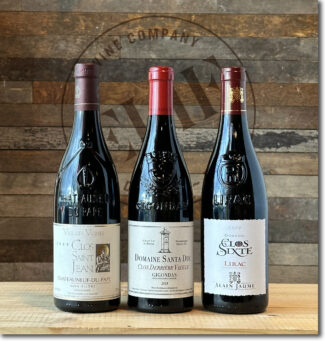
Châteauneuf-du-Pape, Clos Saint Jean ‘Vieilles Vignes’ 2019 red ($58)
A blend of old vine Grenache, Syrah, Mourvèdre, Cinsault, Vaccarèse and Muscardin located in and around lieu-dit Le Crau. The Grenache is aged in concrete for 12 months while the remainder is aged in demi-muid. The fruit is reminiscent of warmed plum sauce and blackberry purée, while the savory side shows up as garrigue, earth and toasted spice.
Gigondas, Domaine Santa Duc ‘Clos Derrière Vieille’ 2018 red ($57)
Produced from old vines in limestone-rich soil, the blend is predominantly Grenache shored up with Syrah and Mourvèdre. Classic Gigondas terroir appears as ripe blueberry and strawberry mingled with black pepper, fresh green herbs, earth, resin and anise.
Lirac, Domaine du Clos de Sixte Lirac 2019 red ($22)
50% Grenache, 35% Syrah and 15% Mourvèdre grown organically under Ecocert. The vineyard soil is mostly limestone, alluvial soils with quartz, sand and rock. Fermentation takes place in stainless steel with hand-sorted, crushed and destemmed grapes.18 days of vatting with pigéage is followed by 16 months in concrete vats and 30% new French oak barrels. The bouquet shows blackcurrant liqueur and pie spice, the palate is full, harmonious and elegant with licorice and vanilla on the finish.
Provence
Once known primarily for somewhat generic pink wine, Provence is—like the rest of France—in the middle of self-examination. It’s true that they are ‘redefining’ game somewhat later than most appellation, primarily because in the words of winemaker Henri Milan (Domaine Milan). “We live in a parallel universe here, entranced by our own charmed lives and abandoning any thought of the world beyond.”
Those lives, beyond the famous rosés, also include Bandol’s Mourvèdre, Cassis’ Clairette, and various permutation of the ancient grape Tibouren. But a handful of pioneers, exploring the back country and delving deeply into the soil, have begun to work with old vine Grenache and Cinsault while discovering that little-known and colder subsets of Provence have warmed to a level where the full diversity of southern grapes can be planted successfully and produce wine without the characteristic heat and high alcohol and retain the essential freshness that discerning palates appreciate.
$137 Red & Rosé Provence Trio: Bandol, Les Baux-de-Provence, Côtes-de-Provence
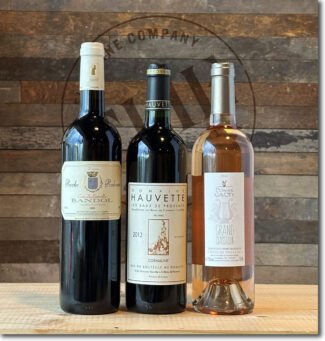
Bandol, Domaine Roche Redonne ‘Cuvée Les Bartavelles’ 2019 red ($69)
95% Mourvèdre and 5% Grenache; the wine’s cuvée name honors the local rock partridges. The vines average 40 years old; the youngest are 20 years and the oldest, 60. The yields are very low and the steep-hilled vineyards can only be harvested by hand. The wine shows boysenberry, blackcurrant, pepper and graphite shored up with well-integrated tannin.
Les Baux de Provence, Domaine Hauvette ‘Cornaline’ 2012 red ($41)
Cuvée Cornaline is a plush blend of 50% Grenache, 30% Syrah and 20% Cabernet Sauvignon farmed biodynamically on cretaceous limestone terroir. Grenache brings fresh strawberry and thyme to the profile, Syrah, black pepper and olive while Cabernet Sauvignon gives its black currant, tobacco and a light, enjoyable smokiness.
Côtes-de-Provence, Domaine Gavoty ‘Grand Classique’ 2022 rosé ($27)
Made of Grenache and Cinsault in roughly equal proportions. Rather than being pressed immediately after harvest as many Provence rosés are, Grand Classique macerates for several hours before pressing, and the saignée and first-press juice are vinified separately. The resulting wine shows strawberry and watermelon electrified by racy acidity.
The Languedoc
The Mediterranean Sea takes a sizeable chunk out of France’s hindquarters, and the bite-shaped crescent contains a few of the most dynamic winegrowing regions in the country. Clockwise, from just north of Spain, Languedoc is a swarthy appellation known for Grenache and Carignan blends—two varieties that love the hot coastal sunshine. Often joined at the hip with neighboring Roussillon, the insanely productive AOP accounts for more than a third of the country’s wine output. Historically, this wine was copious, inexpensive and rather forgettable—everyday wine for the tables of ordinary people. Since the mid-twentieth century, however, with the advent of irrigation in the foothills and coastal plains of Southern France coupled with improved techniques, the region now boasts fewer vines that produce wines of increasing quality.
A jigsaw of soils and a broad swath of microclimates creates ideal terroir for the warm-weather, full-bodied varietals often associated with the Rhône, while sharp diurnal shifts allow for the preservation of aroma and natural acidity, resulting in wines of extraordinary balance. A further plus is that Languedoc-Roussillon’s hot, dry climate discourages the growth of mildew and fungi, making synthetic pesticides and herbicides less necessary. As such, it has become a proving ground for organic and biodynamic producers.
$119 Red Languedoc Trio: Faugères, Terrasses-du-Larzac, Languedoc-Hérault
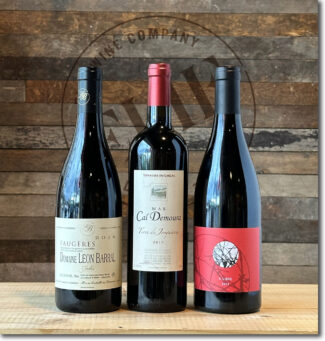
Faugères, Domaine Léon Barral ‘Jadis’ 2016 red ($47)
‘Jadis’ roughly translates as ‘long ago’ or ‘in olden days’—a wistful glance at the traditional way of doing things. Old vine Carignan and Syrah from the domain’s southern-facing vineyards, the wine offers exotic layers of musk, sour cherries and herbs with a mineral and saline finish.
Terrasses-du-Larzac, Mas Cal Demoura ‘Terre de Jonquières’ 2017 red ($32)
30% Syrah, 25% Carignan, 20% Cinsault, 15% Mourvèdre and 10% Grenache, with each variety vinified separately. The initial fermentation occurs in temperature-controlled stainless steel vats, after which the wines are racked into barrels and, after one year of aging, blended. The wine is given an extra six months of aging before being bottled without fining or filtration. The wine offers black fruit, licorice, and garrigue and remains elegant and fresh on the palate.
VdF Languedoc-Hérault, Clos de la Barthassade ‘K Libre – Carignan’ 2019 red ($40)
50% whole cluster Carignan and 24 months élevage in demi-muid and concrete egg produces a wine with an amazing array of spices on the nose; potpourri, Asian spices and sandalwood with a bright mineral overtone and a touch of smokiness. The palate is driven by fruit, especially raspberry.
The Roussillon
Author Jon Bonné refers to the sweet, fortified, Grenache-based wines of Banyuls as ‘Port that isn’t trying too hard.’ Likewise the Muscat-based wines of Rivesaltes, just to the north, whose fully oxidized, dry wines native come across like France’s response to Sherry.
But the real interest in today’s world is dry, intensely mineral red and white wines being made there these days; a factor that may be confused when Roussillon’s best dry wines are lumped in with Languedoc to the north, doing a disservice to both appellations. Roussillon’s current focus is clear: Acid-driven wines that are unquestionably southern, but also subtle, as winemakers have found a way to modulate the sun. In part this involves impeccable, often organic farming to make wines whose complexity rivals top Rhônes.
Roussillon’s affordable land also makes it a magnet for a lot of natural-wine pioneers including naturalist icons like Edouard Laffitte of Le Bout du Monde, whose easygoing wines mirror those of several like-minded vignerons and prompted their village of Lansac to be dubbed Jajakistan—an in-joke derived from French slang for gluggable wine.
$104 Red Roussillon Trio: Collioure, Maury, Corbières
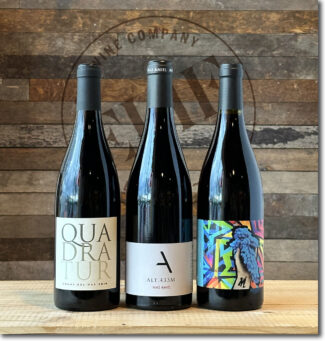
Collioure, Coume del Mas ‘Quadratur’ 2016 red ($37)
50% Grenache Noir, 30% Mourvèdre and 20% Carignan from high-altitude old vines with concentrated, low yield fruit. In the winery, strict hand and table sorting precedes a long maceration and fermentation intended to extract maximum flavor, followed by 12-14 months in oak barrels before bottling without filtration. The wine showcases delicious notes of dark fruits, spices, wild herbs and earth.
Maury, Mas Amiel ‘Alt.433m’ 2017 red ($36)
The plot for this wine was planted in 1962 with Grenache and Lladoner Pelut vines at an altitude of 433 meters—hence, the name. Lladoner Pelut is a natural mutation of Grenache which reaches phenolic ripeness sooner and produces wines with a lower alcohol content; it is more commonly used in the wines of Priorat, Catalunya. It offers delicate notes of crushed stone, cranberries and fresh herbs in a silky package with hints of orange zest and rose hips.
VdF Roussillon-Corbières, Domaine Yohann Moreno ‘GS’ 2021 red ($31)
A fun, ‘glou-glou’ style of light Grenache and Syrah; a crunchy core of candied blueberry is offset by a bit of minerality.
Corsica
Corsica has been described as penumbral Italy and Sardinia’s French twin, although in fact, it is very much a wine-producing appellation with its own native soul. Corsicans are imbued with a vehement sense of pride and independence, born in part from perpetual watchfulness: As winemaker Christian Giacometti shares, “The reason our villages were never near the sea is that the Corsicans were always fending off invaders.”
Corsican vignerons work with a roster of seemingly unpronounceable varieties like Sciaccarellu, Biancone and Paga Debiti. In the past couple of decades, these sumptuous, spicy wines have found a growing patronage among those of us in the west eager to learn more about a peripheral Mediterranean gem and these island wines, created without France’s intellectualism or Italy’s numbing regulations and crowd-pleasing varieties, opting instead for face-value frankness and above all, native grapes.
$117 Red & White Corsica Trio: Patrimonio, Corse Figari
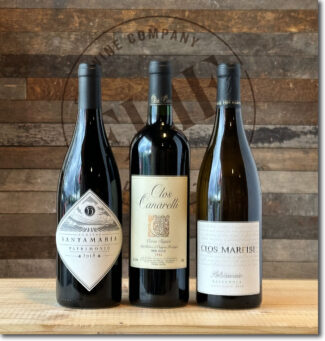
Patrimonio, Domaine Santamaria 2018 red ($37)
100% Nielluciu from 25-year-old biodynamic vines grown in a microclimate meliorated by the Ligurian Sea, where soils are (unlike much of Corsica) largely composed of chalky clays and limestone. The grapes are hand-picked and fermented on native yeast, then bottled without fining. Patrimonio is the first AOP in France to forbid chemical weeding; the wine shows cranberry and raspberry with a touch of earthy minerality and spice.
Corse Figari, Clos Canarelli 2016 red ($45)
The soils of the Figari AOP make up France’s southernmost wine region, and it is maintained by many that this bottling represents the best profile of the Sciaccarellu grape to be found. The bright sunshine and granite soils of the southwest part of the island are a perfect cradle for the grape and the wine shows it’s characteristic herbal spice behind soft berry notes and easy tannins.
Patrimonio, Clos Marfisi ‘Ravagnola’ 2020 white ($35)
Vermentino (known in Corsica as Vermentinu) shows off its island expression as floral, with bright flashes of citrus and an almost salty finish, quite reflective of the clay, chalk and schist soils less than a mile from the sea.
A Gift That Keeps On Giving
Membership To ‘The Champagne Society’
Bimonthly Subscription
 Not only is Champagne the quintessential drink of celebration, it has traditionally been a gift given with ramped-up sentiments. This year we are offering a couple of variations on this theme, beginning with an opportunity to gift a special someone a six-month or twelve-month membership to The Champagne Society. Our pick for December will be packaged in a wrap-ready gift box along with a congratulatory certificate explaining what lies ahead in bi-monthly installments. For more information please visit our website page: A Holiday Gift: ‘The Champagne Society’ Membership 6-Month ($299) or 12-Month ($589) Subscription.
Not only is Champagne the quintessential drink of celebration, it has traditionally been a gift given with ramped-up sentiments. This year we are offering a couple of variations on this theme, beginning with an opportunity to gift a special someone a six-month or twelve-month membership to The Champagne Society. Our pick for December will be packaged in a wrap-ready gift box along with a congratulatory certificate explaining what lies ahead in bi-monthly installments. For more information please visit our website page: A Holiday Gift: ‘The Champagne Society’ Membership 6-Month ($299) or 12-Month ($589) Subscription.
Elie
- - -
Posted on 2023.12.15 in France, Wine-Aid Packages | Read more...
Featured Wines
- Notebook: A’Boudt Town
- Saturday Sips Wines
- Saturday Sips Review Club
- The Champagne Society
- Wine-Aid Packages
Wine Regions
Grape Varieties
Aglianico, Albarino, Albarín Blanco, Albarín Tinto, Albillo, Aleatico, Aligote, Arbanne, Aubun, Barbarossa, barbera, Biancu Gentile, bourboulenc, Cabernet Franc, Caino, Caladoc, Calvi, Carcajolu-Neru, Carignan, Chablis, Chardonnay, Chasselas, Cinsault, Clairette, Corvina, Counoise, Dolcetto, Erbamat, Ferrol, Frappato, Friulano, Fromenteau, Gamay, Garnacha, Garnacha Tintorera, Gewurztraminer, Graciano, Grenache, Grenache Blanc, Groppello, Juan Garcia, Lambrusco, Loureira, Macabeo, Macabou, Malbec, Malvasia, Malvasia Nera, Marcelan, Marsanne, Marselan, Marzemino, Mondeuse, Montanaccia, Montònega, Morescola, Morescono, Moscatell, Muscat, Natural, Niellucciu, Parellada, Patrimonio, Pedro Ximénez, Petit Meslier, Petit Verdot, Pineau d'Aunis, Pinot Blanc, Pinot Gris, Pinot Meunier, Pinot Noir, Pouilly Fuisse, Pouilly Loche, Poulsard, Prieto Picudo, Riesling, Rondinella, Rousanne, Roussanne, Sagrantino, Sauvignon Blanc, Savignin, Sciacarellu, Semillon, Souson, Sparkling, Sumoll, Sylvaner, Syrah, Tannat, Tempranillo, Trebbiano, Trebbiano Valtenesi, Treixadura, Trousseau, Ugni Blanc, vaccarèse, Verdicchio, Vermentino, Xarel-loWines & Events by Date
- May 2024
- April 2024
- March 2024
- February 2024
- January 2024
- December 2023
- November 2023
- October 2023
- September 2023
- August 2023
- July 2023
- June 2023
- May 2023
- April 2023
- March 2023
- February 2023
- January 2023
- December 2022
- November 2022
- October 2022
- September 2022
- August 2022
- July 2022
- June 2022
- May 2022
- April 2022
- March 2022
- February 2022
- January 2022
- December 2021
- November 2021
- October 2021
- September 2021
- August 2021
- July 2021
- June 2021
- May 2021
- April 2021
- March 2021
- February 2021
- January 2021
- December 2020
- November 2020
- October 2020
- September 2020
- August 2020
- July 2020
- June 2020
- May 2020
- April 2020
- March 2020
- February 2020
- January 2020
- December 2019
- November 2019
- October 2019
- September 2019
- August 2019
- July 2019
- June 2019
- May 2019
- April 2019
- March 2019
- February 2019
- January 2019
- December 2018
- November 2018
- October 2018
- September 2018
- August 2018
- July 2018
- June 2018
- May 2018
- April 2018
- March 2018
- February 2018
- January 2018
- December 2017
- November 2017
- October 2017
- September 2017
- August 2017
- July 2017
- June 2017
- May 2017
- April 2017
- March 2017
- February 2017
- January 2017
- December 2016
- November 2016
- October 2016
- September 2016
- August 2016
- July 2016
- June 2016
- May 2016
- April 2016
- March 2016
- February 2016
- January 2016
- December 2015
- November 2015
- October 2015
- September 2015
- August 2015
- July 2015
- June 2015
- May 2015
- April 2015
- March 2015
- February 2015
- January 2015
- December 2014
- November 2014
- October 2014
- September 2014
- August 2014
- July 2014
- June 2014
- April 2014
- March 2014
- February 2014
- January 2014
- December 2013
- November 2013
- October 2013
- September 2013
- August 2013
- July 2013
- June 2013
- May 2013
- April 2013
- March 2013
- February 2013
- January 2013
- December 2012
- November 2012
- October 2012
- February 2004



